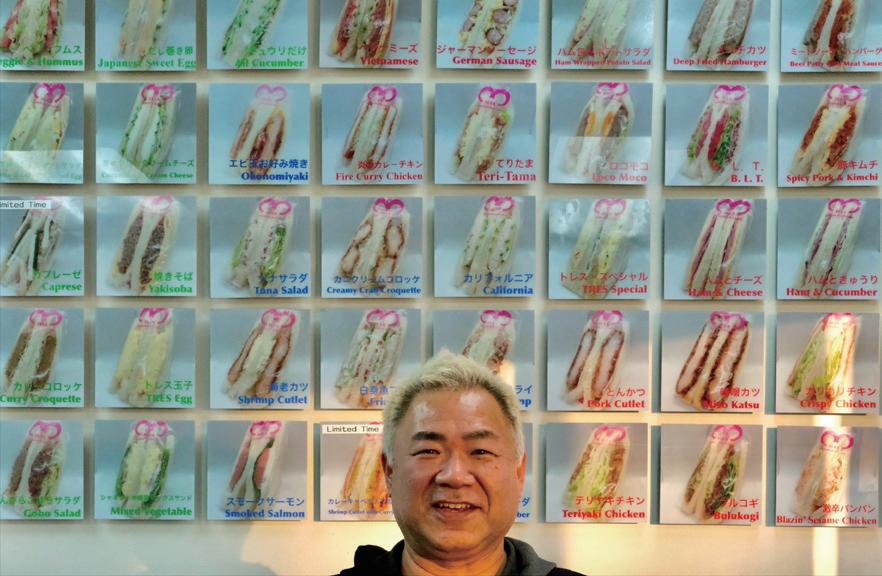










Your Link to SEATTLE’S JAPANESE COMMUNITY Since 1902 HAPPY NEW YEAR 2023 新年特別号 January 1, 2023 Vol. 77, Issue 24 Published Every 2nd and 4th Friday
Makoto Ogasawara of Sandwich House TRES discusses making sandwiches that Japanese want to eat (p. 19).
PRSRT STD U.S. POSTAGE PAID SEATTLE WA PERMIT NO. 1153 The North American Post 519 6th Ave. S., Seattle, WA 98104 Change Service Requested www.napost.com Like us on Facebook @TheNorthAmericanPost New Year's Day Special Bilingual Edition A new Japantown banner project seeks community design input (p. 18). NEWS Japantown Banners VOICES Japanese Sandwiches
"Year of the Rabbit" by Aki Sogabe


JANUARY (Mutsuki) - FEBRUARY
Mutsuki, month of good relationships
Terry’s Kitchen, “The OBGs,” New Year’s Eve, Dec. 31, 9-12:30 PM, Info: terryskitchenbellevue.com
Tsubaki Grand Shrine of America Hatsumoude, New Year First Shrine Visit. Info: tsubakishrine.org
• Sun Jan 1, 8:30 AM - 3:30 PM
• Mon Jan 2, 9:30 AM - 3:30 PM

UW Japan Studies
“Green with Milk and Sugar: When Japan Filled America’s Tea Cups” with Robert Hellyer, Wake Forest University. Fri Jan 6, 12 – 1:20 PM, Smith Hall 306. Info: jsis.washington.edu/japan/events
UW Cinema & Media Studies
Film Screening with Director Ann Kaneko, “Manzanar Diverted: When Water Becomes Dust,”
Fri, Jan 27, 4:30 PM, Henry Art Gallery. Info: cinema.washington.edu
Seattle Kobe Sister City Association, Sister City Beer Launch, Friday, Jan. 6, 5 – 7 PM , Lucky Envelope Brewing, Ballard. Info: seattlekobe.org (article, p. 22)


Japan America Society of the State of Washington, “Eiichi Shibusawa and the Birth of JASSW,” Thurs Jan 12, 5:30 - 8:30 PM. Seattle Union Square Boardroom. Info: jassw.org

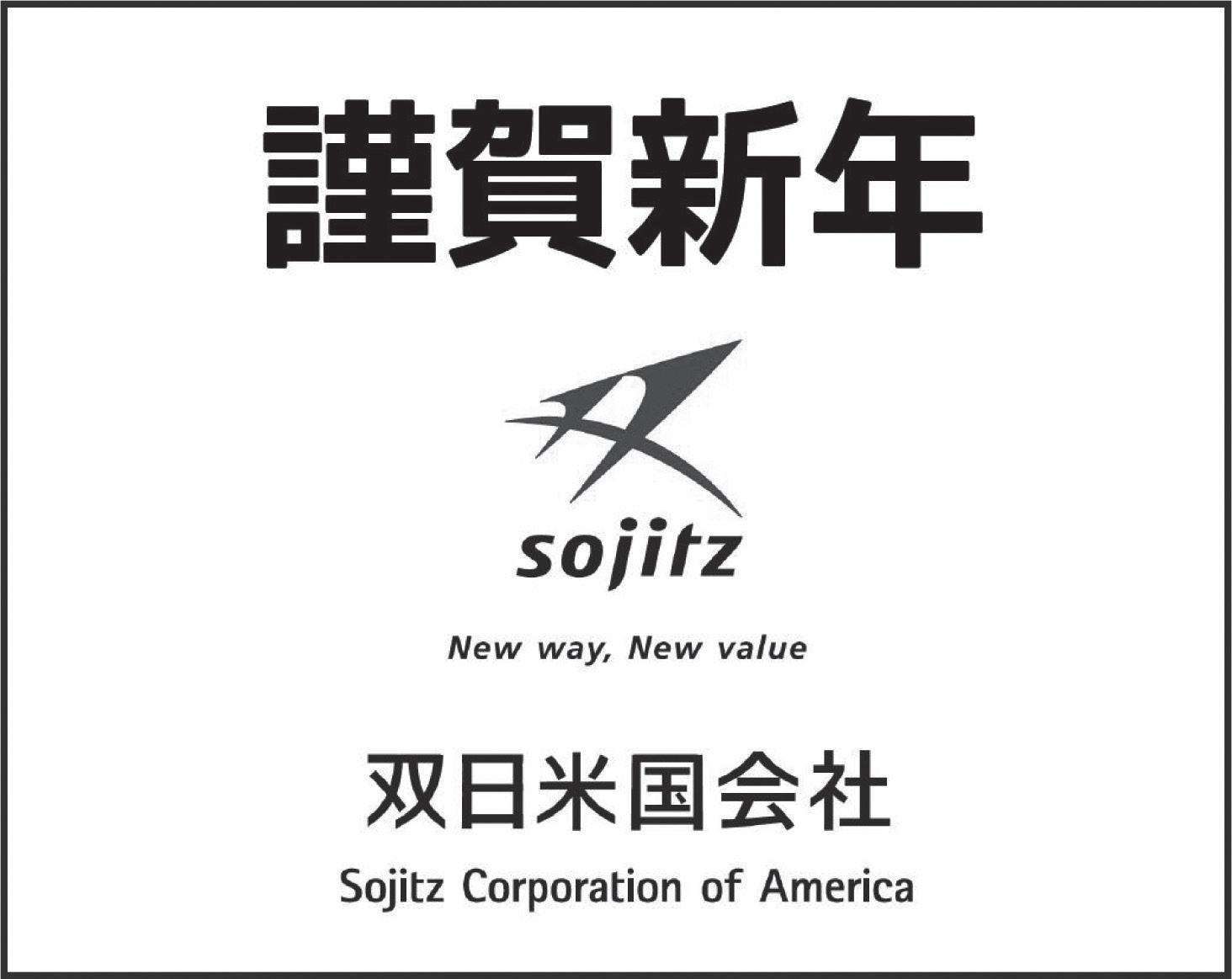


Fourth Annual Seijin-Shiki USA, Sun Jan 15, 1 - 3 PM. Venue changed to Sammamish High School. Info: seijinusa.org (NAP article, Dec. 9)

Kodo, One Earth Tour – Tsuzumi, Fri-Sat, Jan. 27-28, Meany Center, Info: meanycenter.org (ad, p. 14)

Yamato: The Drummers of Japan Thu Feb 16, 7:30 PM, Moore Theatre, Seattle. Info: stgpresents.org
ONGOING
“Resisters: A Legacy of Movement from the Japanese American Incarceration.” It features Nikkei artists Lauren Iida, Kayla Isomura, Paul Kikuchi, Michelle Kumata, Glenn Mitsui, Erin Shigaki and Na Omi Shintani. Info: wingluke.org (also napost.com, Oct. 29)
CLASSIFIED ADS

GPI US is hiring a Head Coordinator for Japanese HS students in the Seattle area from Feb. 5 – 10.
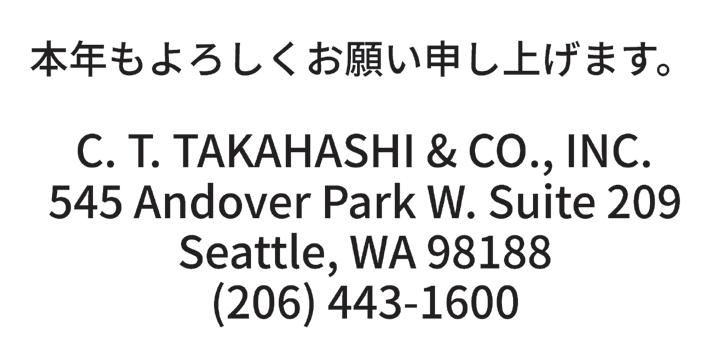

Applicants must be able to work 8 hours/day and have experience with students and leading groups. Email allison@gpius.net, http://www.gpius.net
Heart Mountain Foundation seeks new permanent Executive Director to lead the Mineta-Simpson Institute. This is a rare opportunity to work in Japanese American history. However, the job would entail living in Wyoming. Info@heartmountain.org.
4 The North American Post Vol. 77 Issue 24 January 1, 2023 napost.com
CALENDAR
Happy Year of the Rabbit to our community of readers and advertisers. We are grateful for your support. Last year, the North American Post celebrated its 120th anniversary and its sister Japanese-language publication, Soy Source, celebrated its 30th anniversary. At the risk of boasting just a bit, those are pretty amazing accomplishments. The North American Post Publishing Company has been through world wars, a global pandemic, one Great Depression, and any number of recessions, and yet, here we are, still publishing on a regular basis. Thanks to the ongoing support of our Nikkei and expat Japanese communities during all these years, we accomplished our mission of bringing you relevant local news and advertising.

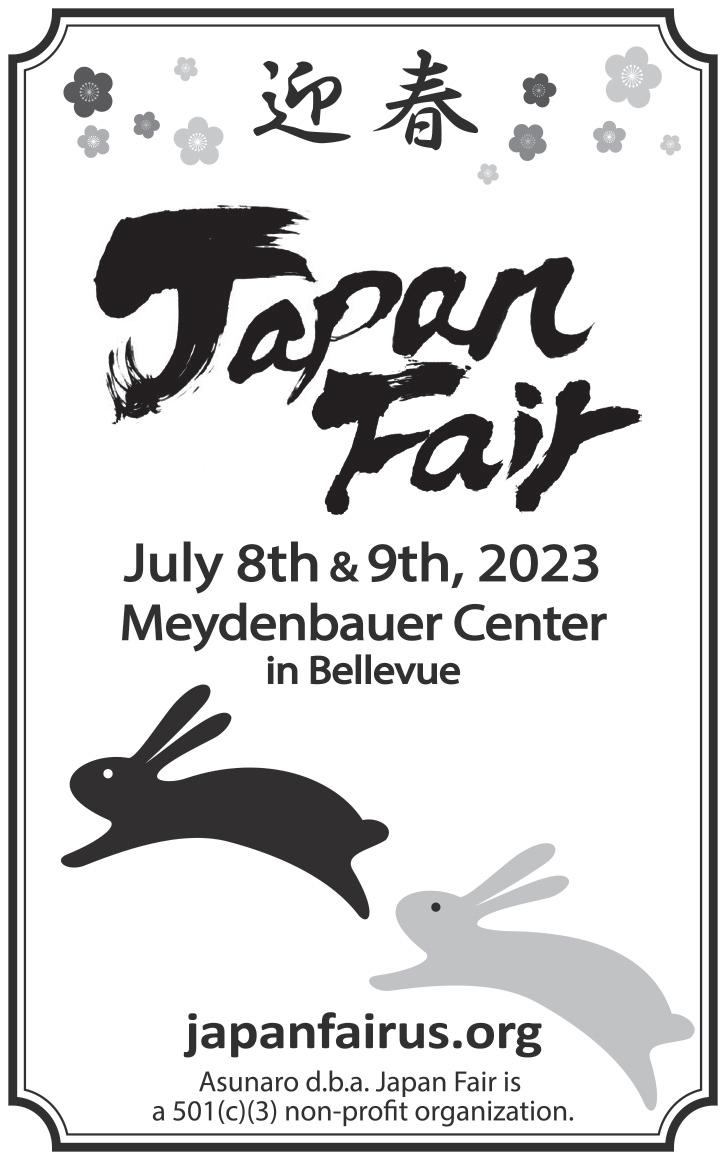

In some ways, this is a very difficult time for media companies like ours. Few community newspapers still exist. Yet, on the other hand, the sort of “hyperlocal” news we deliver in every issue and on our website is more important than ever. Mainstream media doesn’t have the time or the staff to cover events that are important to our community and thus we feel our mission is as vital as ever. We are also planning for the future. You’ll be hearing soon about new developments that we hope will bring our communities closer together, both online and in person.
On behalf of the management, staff, and board members of the North American Post, Soy Source, and the Hokubei Hochi Foundation, we wish you a healthy and prosperous 2023.
 Tomio Moriguchi Chairman, The North American Post Publishing Company
Tomio Moriguchi Chairman, The North American Post Publishing Company

Happy New Year!
Shodo Kenkyukai

Publisher: General Manager Editor:
Jpn. Editor: Accounting: Advertising: Contributors: Jpn. contributor: Proofreader: Cover Art: Calligraphy:

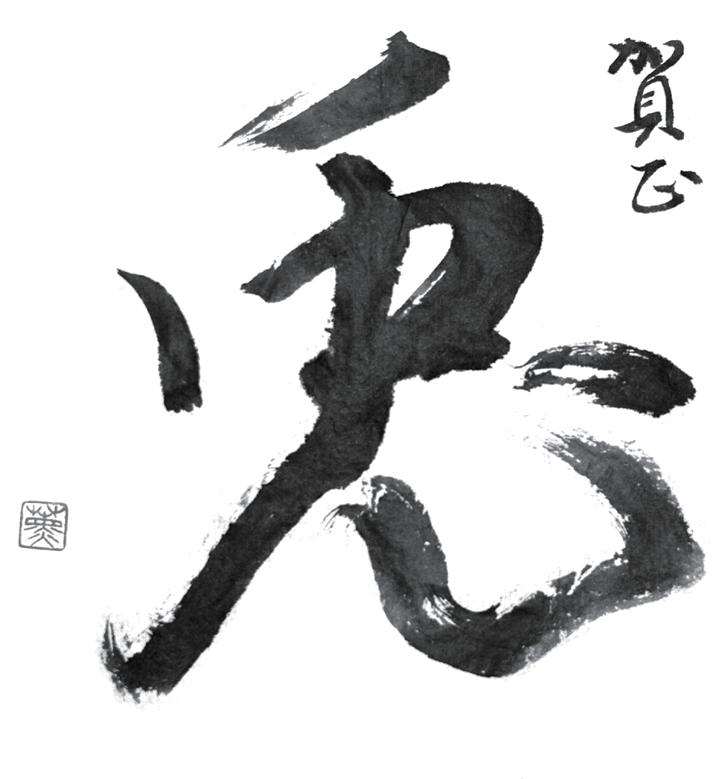
Tomio Moriguchi Bruce Rutledge David Yamaguchi david@napost.com Hikari Kono hikari@napost.com Mie Ohno Ako Mizoe Masashi Ueda Aya Chiong-Bisbee Edward Echtle Elaine Ikoma Ko Reika Nishiyama Geraldine Shu Shokichi Tokita Shihou Sasaki Geraldine Shu Aki Sogabe Kaoru Green
Published by (address NOT for mail) North American Post Publishing, Inc. 519 6th Ave. So. Suite 200, Seattle WA 98104


Some of you may recognize me as an occasional contributor to the North American Post or for my publishing work on various books related to Japan. Late in 2022, the North American Post board asked me to join the team and help its publications ramp up as we begin to emerge from a long pandemic. I was honored to get the call. I've had a long fascination with publishing and the news media, having worked at the Nihon Keizai Shimbun and other news organizations during the 1990s in Japan. I'm also fascinated with how news consumption and delivery of that news has evolved. I don't know all the answers as to what the future will bring to this industry (if I did, I would be a very rich man!) but I look forward to digging into the issues that the North American Post Publishing Company faces and coming up with our own answers over the next year. I look forward to getting to know many of you regular readers and advertisers in the Year of the Rabbit and hearing your ideas. What would you like to see in the pages of the North American Post and Soy Source? What can community newspapers do to help you and your business? Let’s talk. Wishing all of you a happy and thriving 2023.
Bruce Rutledge

General Manager, North American Post and Soy Source
Year of the Rabbit drawings by students, p. 15
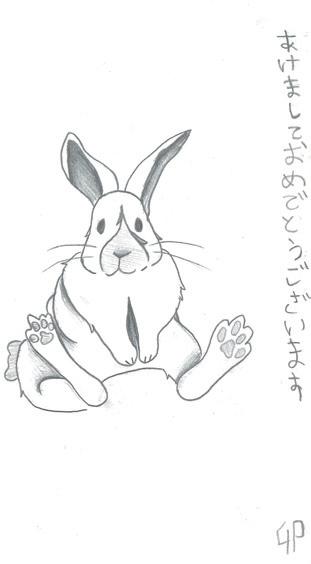
www.napost.com Like us on Facebook @TheNorthAmericanPost


Advertise
Contact: ako@napost.com Subscribe
$46 for 1 year | $84 for 2 years Contact: https://subs@napost.com Subscribe Online: www.napost.com/subscribe
Checks Payable to: The North American Post P.O. Box 3173 Seattle, WA 98114 We accept Visa/Mastercard/Discover Card
Subscription Form
Subscriber Info Name: Tel: ( ) - Email: Mailing Address: Payer Info (if different from Subscriber) Name: Tel: ( ) - Email: Billing Address:
Credit Card Info (if paying with credit card ) Payment with Visa / Master / Discover Card Card No. _______- _______-_______-_______ Expiration Date __ / __ Security Code ________






5 The North American Post Since 1902 napost.com
GREETINGS New Year's
Beikoku
揮毫 =米国書道研究会シアトル支部 グリーン薫 新年特別号 Season’s Greetings from Our Chairman The North American Post January 1, 2023, Vol. 77, Issue 24
Calligraphy by Kaoru Green
Printed
in Canada
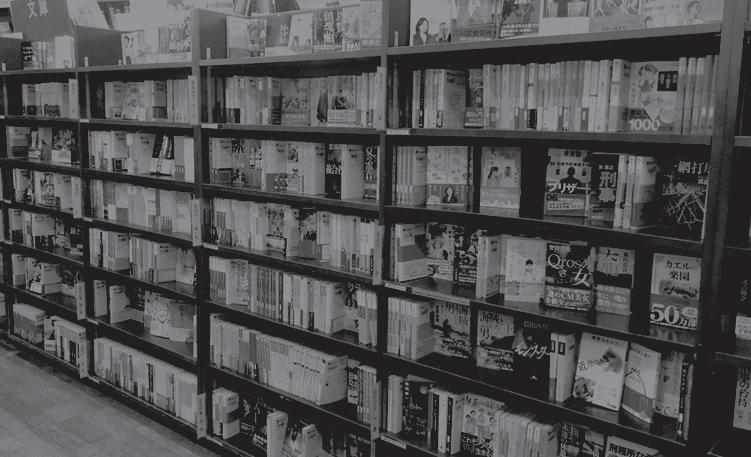











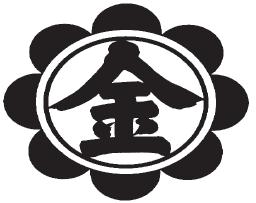








6 The North American Post Vol. 77 Issue 24 January 1, 2023 napost.com VOICES
ム平和協定が結ばれたのは1973 年だった。同年10月には第四次中東
が発生した。 同じく戦争に絡んでくるが、 2001年の同時多発テロ事件で崩 壊したニューヨークのワールドトレ ードセンターは73年に正式開業。シ アトル出身で日系二世の建築家ミノ ル・ヤマサキ(山崎稔)氏が設計し たことでも知られる。 サッカーのワールドカップは今年 終盤を大いに盛り上げ、日本代表の 健闘と惜敗が鮮明に記憶される。米 国では大リーグで大谷翔平選手らの 活躍が新シーズンも期待される。新 たな日本選手として吉田正尚外野手、 千 せんが 賀 滉 こうだい 大 投手の契約が発表されて いる。 最後に当地において、23年にワシ ントン州と兵庫県が姉妹州60年とな る。50周年を迎えたときが思い出さ れるが、10年はあっという間だった 。その日、その年を大切に新たな一 年を迎えたい。 間もなく2023年 文:佐々木 志峰 おおらかに生きたきものよ初鏡 初茜えさ場に急ぐ鳥の群それぞれの抱負二文字筆はじめ「頑張れ」と包みに書きしお年玉 如何にして歩いてゆこう良寛忌 八幡の鳥居くぐれば去年今年 初詣大社の庭で深呼吸少しずつ子らの好みや節料理 レーニア山尊き日の出 年 としあらた 新 初富士やコーヒー熱き新幹線 去年より目出度き命臼起し外つ国に深き会釈の御慶かな年立ちて同じまんまの気持ちかな 修正のきかぬ余生や年新た初東風や「北風小僧」口につき缶汁粉手も温まる初詣古里に少し遅れて今朝の春初凪や見やれり島の長かりし レニア吟社 新年一人一句 2023年 久間照子 茂木ひさを 根岸幸子 秋吉美幸 ミラーこうし 汀泉信子 吉原クリステイ光風 スティーブンス多喜子 阿賀嶺泰子 吉迫まありい ラインウェバー友子 卜円伎鬼 細野やすい ハントシンガー典子 キルシュ絵梨子 バクマスター絵美 加藤わか葉 神田美鈴 キャンプレーン久美子 楠見房子 田宮愛子 土居万亀子 リーあふひ 帆足敏子 シアトル短歌会詠草 2023 年新年 御題『友』 旧友と「ちゃん」付けしての長電話 時差があっても声はすぐそば 癌宣告されたる友の入院の 知らせに膝の震え止まらず 「お元気?」と友より電話お互ひの 安否を確かめ今日は終はりぬ アラスカの闇夜に緑の帯映ゆる オーロラの写真友より届く 原爆を逃れて拾いし命だと お茶を飲みつつ友は語りぬ 久々に会えばはしゃいで学友は 遥かな少女をみえかくれさせ はらからも友も逝きたる吾が卒寿 冬の夜更けの寒さ身に沁む
Seattle Nichiren Buddhist Church (425)861-5574 2022年の締めくくりを迎えた。 日本ではその年の世相を表す「今 年の漢字」に「戦」が選ばれたとい う。戦争、新型コロナウイルス、ス ポーツ行事など、さまざまな部分で 「戦い」があったと見られたようだ。 観光庁発表の統計では、個人旅行の 受け入れを再開してから訪日外客数 は10月に50万人近くに達した。9 月の約20万から大幅増。新型コロナ ウイルス感染拡大以前の賑わいは戻 るだろうか。 筆者個人としては経済、社会の回 復を肌身で感じつつ、体調不良も経 験しながら乗り切った一年だった。 2023年が近づき、節目を迎えそ うな歴史的出来事を主観ながら振り 返ってみた。近代で見ると、1873 年に学制に基づいた初等教育で初の 学校が日本で開校されたという。東 京師範学校付属小学校だそうで、現 在の筑波大学付属小学校になる。 世界各地の自然災害は止むことは ないが、1923年には関東大震災 が発生している。大きな断層が走り、 いつ大地震が起きてもおかしくない と言われるシアトル。備えを再確認 したい。 胸を痛ませ続けているウクライナ 情勢。50年前も戦争、紛争が世界で 続いていた歴史が残る。10数年に及 ぶ米国の軍事介入を終わらせ、ベトナ
戦争が起き、第一次オイルショック
Nichiren
statue, Kyoto.
CC 2.0
Photo:
Chris Gladis, wikimedia


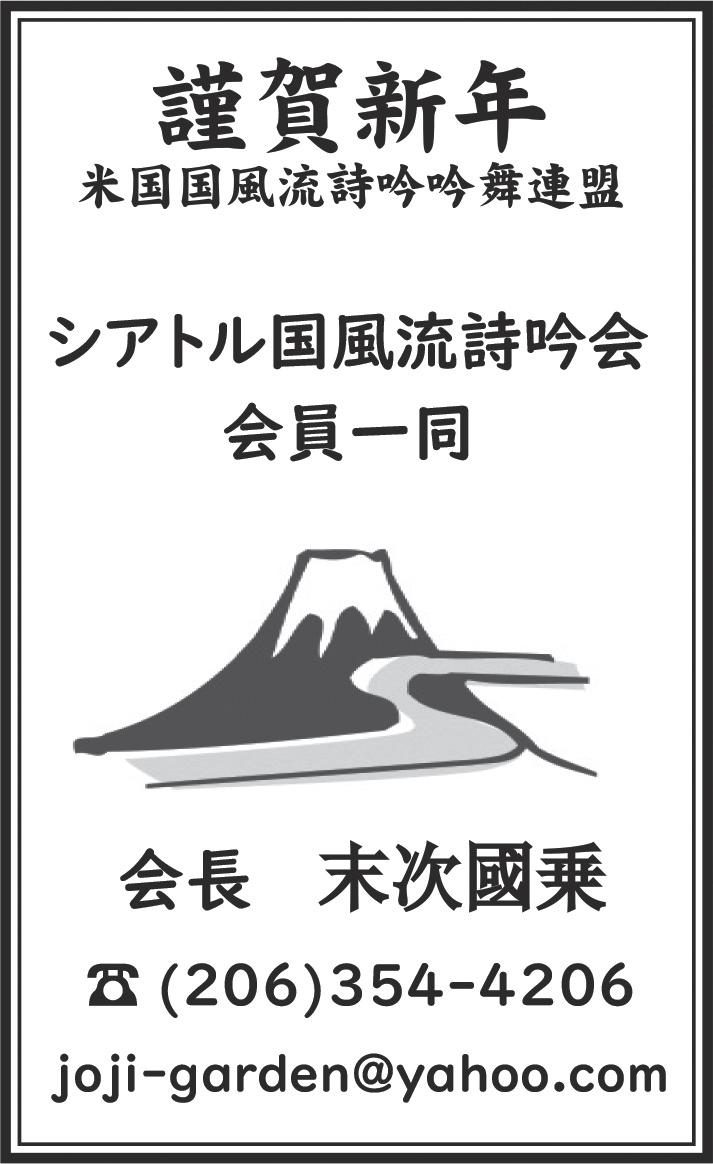



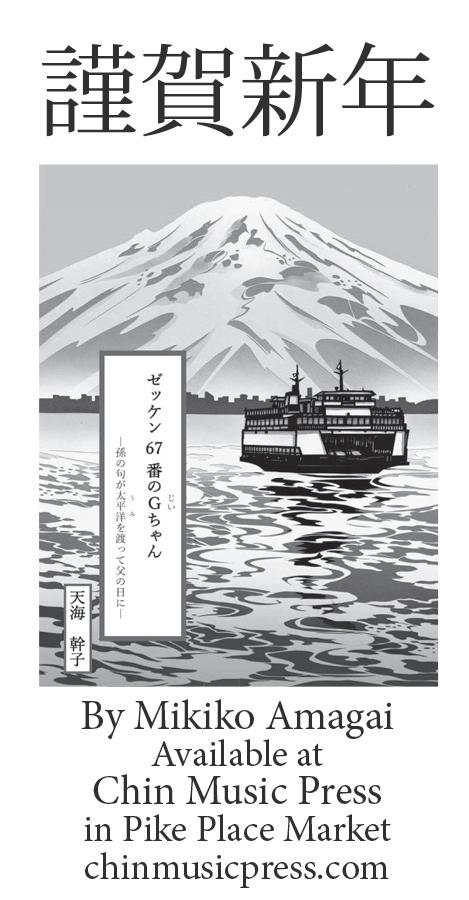




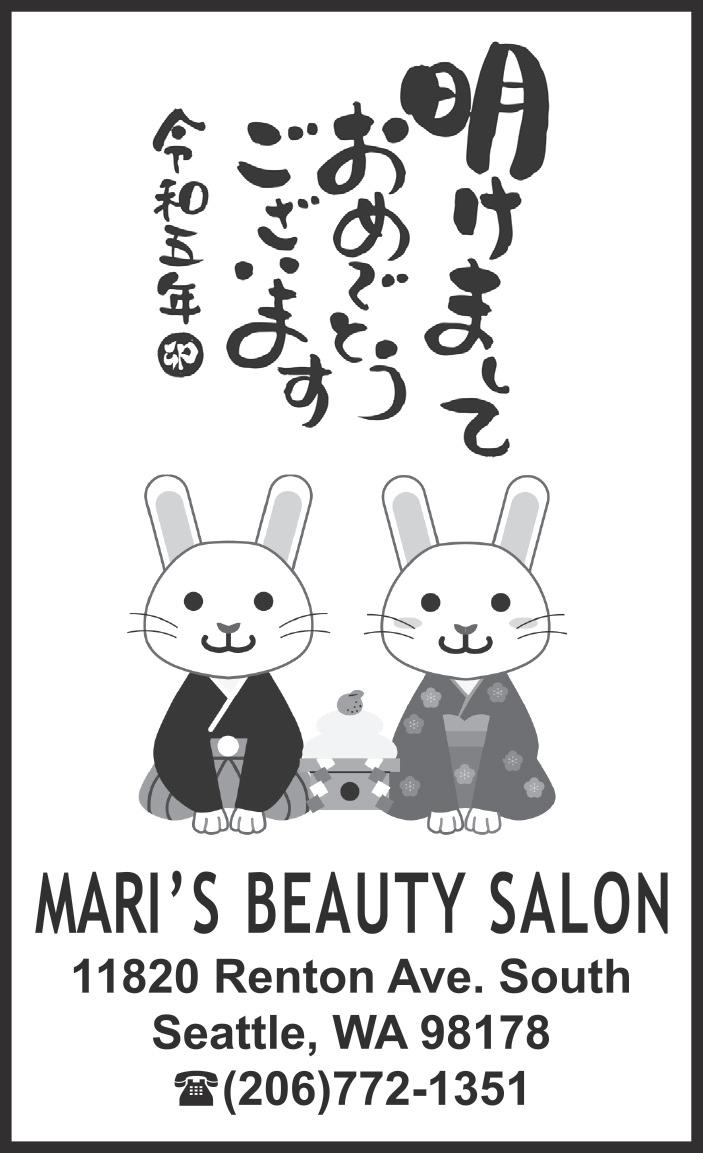

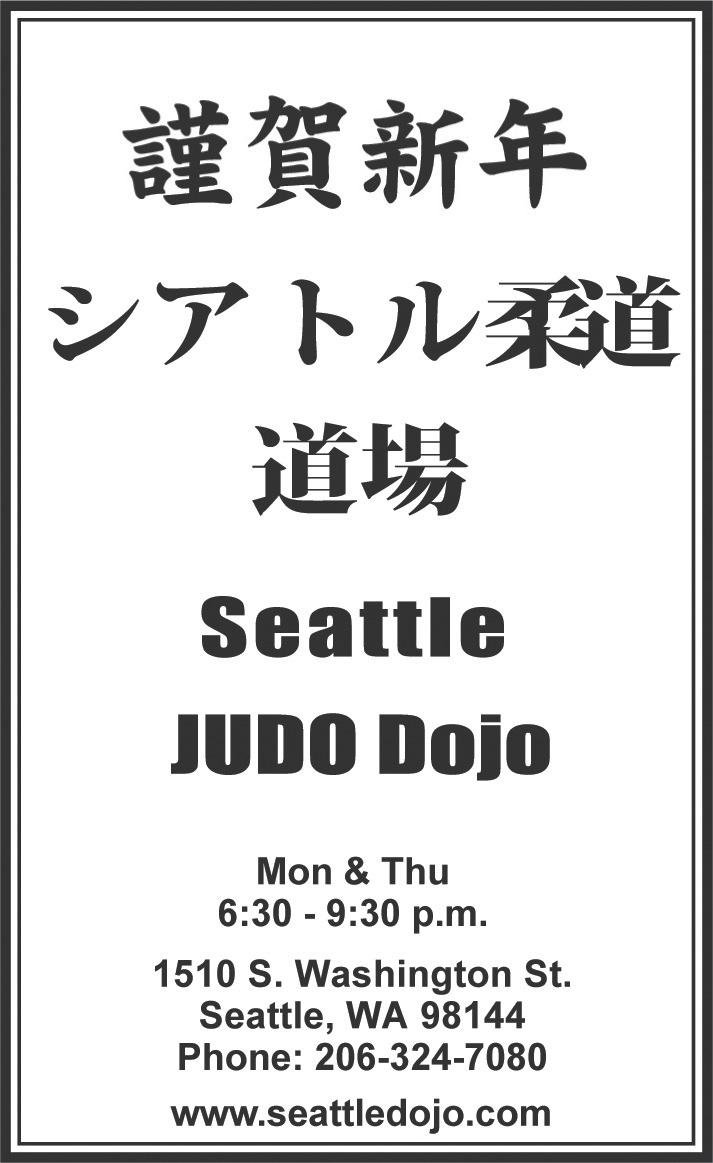


7 The North American Post Since 1902 napost.com
TOKITA TALES Only in America
By Shokichi Tokita For The North American Post


Mom became quite a businesswoman after Papa passed away in October 1948 after a ten-month illness caused by a severe case of diabetes. It took her a while to adjust and come to the realization that at age 41, she was more than just the mother of eight children, ages 2 to 14. Once she recognized that she was fully in charge, she gradually changed from being wife and mother to head of the family with total responsibility for raising the children as well as providing for their well-being. With not much more than a sixth-grade education in Japan, she attended a couple of years at Bailey Gatzert Elementary School and two years at Broadway High School. (Mom explained to me that there was a special section that was set up for foreigners to attend English-speaking classes, which she compared to a junior high school.) It makes me wonder what her thoughts were at that time.
Over the next several months, Haruko gradually took charge and assumed the responsibilities of head of the family, a role she eventually developed that focused on business. Her assumption was that she would not be able to support her family without a business outlook, so her energy was directed toward that end. It was fortuitous that she grew up at the Wilson Hotel (Haruko’s hotel experience #1) on Dearborn Street, where the Uwajimaya parking lot is now located, helping her father and mother in her younger days (Shokichi Tokita, “The Seattle Uwajimaya Parking Lot,” napost.com, Mar. 2022). She then helped run the Cadillac Hotel (#2) on Second and Jackson not long after marrying Kamekichi Tokita. After the war, she also ran the New Lucky Hotel (#3), located at Maynard and Weller in Chinatown, today called the International District.
Haruko started to reach out to the Japanese business community by joining the Japanese American Hotel and Apartment Association (see Ikuo Shinmasu, Flourishing Japanese Hotel Businesses, napost.com, Aug. 13 & 29, 2022). There, she was able to mingle with those in the same business, to further learn and plan. She became aware that she could purchase and own a business and property, contrary to laws that had precluded Japanese from doing so before World War II. She made a variety of contacts both in business and in government. This became a key element that led to opportunities for additional business ventures.
In the late summer of 1949, one of her new associates from the city advised her of a 50-unit hotel that had gone out of business and would be up for sale shortly. This was the Fremont Hotel (#4) on 6th Avenue between Dearborn and Lane. It was located approximately a block from the New Lucky Hotel, her family’s location at that time. In fact, it was where the Uwajimaya parking lot’s attendant hutch is now. She purchased it as her first business venture, which she turned into an excellent, supplemental income source.
Shortly thereafter, she purchased a third hotel through similar lines of business and contacts. This was the Baranoff Hotel (#5), located at the foot of Yesler, just east of the waterfront. This hotel was considerably smaller than both the New Lucky and
the Fremont. It had only 14 rooms but was in much better shape than the first two hotels. Also, it had tenants who were of a much higher class than those at the other two. In fact, it currently houses business offices.
Next came an apartment building in 1955. Haruko purchased the Laurel Apartments (#6) in 1955, located at 22nd Avenue and Main Street. This was the first opportunity for her family to live away from the Chinatown and downtown areas in a more residential atmosphere. It had approximately 25 units situated on two floors with an adjacent garden area outside. It was also closer to the children’s schools: Shizuko was enrolled at Immaculate Conception School, Yasuo and Yuzo at Garfield High School, Yoshiko at Holy Names Academy, Masao and Goro eventually at Seattle Preparatory School and Yaeko later also at Holy Names.
At this point, let me backtrack a little bit to talk about one of the very, very high points in Haruko’s life. She was well-aware of the various exclusions the Japanese people in America were subjected to by U.S., state and local governments. They were denied citizenship, land ownership, jobs, and various other liberties. However, after WWII and the gradual assimilation of the Japanese in America, the U.S. government, under the McCarran-Walter Act of 1952, decided to allow the Japanese as well as other immigrants in America to become naturalized citizens in 1953.
After the law was enacted, Haruko was one of the first to start attending classes to learn about the examination each applicant was required to pass to become a naturalized U.S. citizen. After attending classes, she took the exam and without any fanfare or notoriety, she passed! So, on November 16, 1953, she was awarded a naturalization certificate of US citizenship.

This was one of Haruko’s happiest moments. She was quite emphatic and was supremely excited about this accomplishment. She would excitedly talk about
Above: Haruko’s US naturalization certificate.
Photo: Tokita family
Below: The Fremont Hotel, on Sixth Avenue between Lane and Dearborn. Other mentioned properties are not on the map. In some cases, this is because they had western names, so were not recognized as Issei-owned hotels by the map-maker. In other cases, they lay beyond the boundaries of the mapped Chinatown neighborhood.
Map: Kazuo Ito, “Issei,” 1973 (photo: David Yamaguchi).
her citizenship from time to time and was genuinely pleased at acquiring it. When complimented in later years, primarily about raising eight children by herself, without any welfare assistance, she would explain in Japanese:
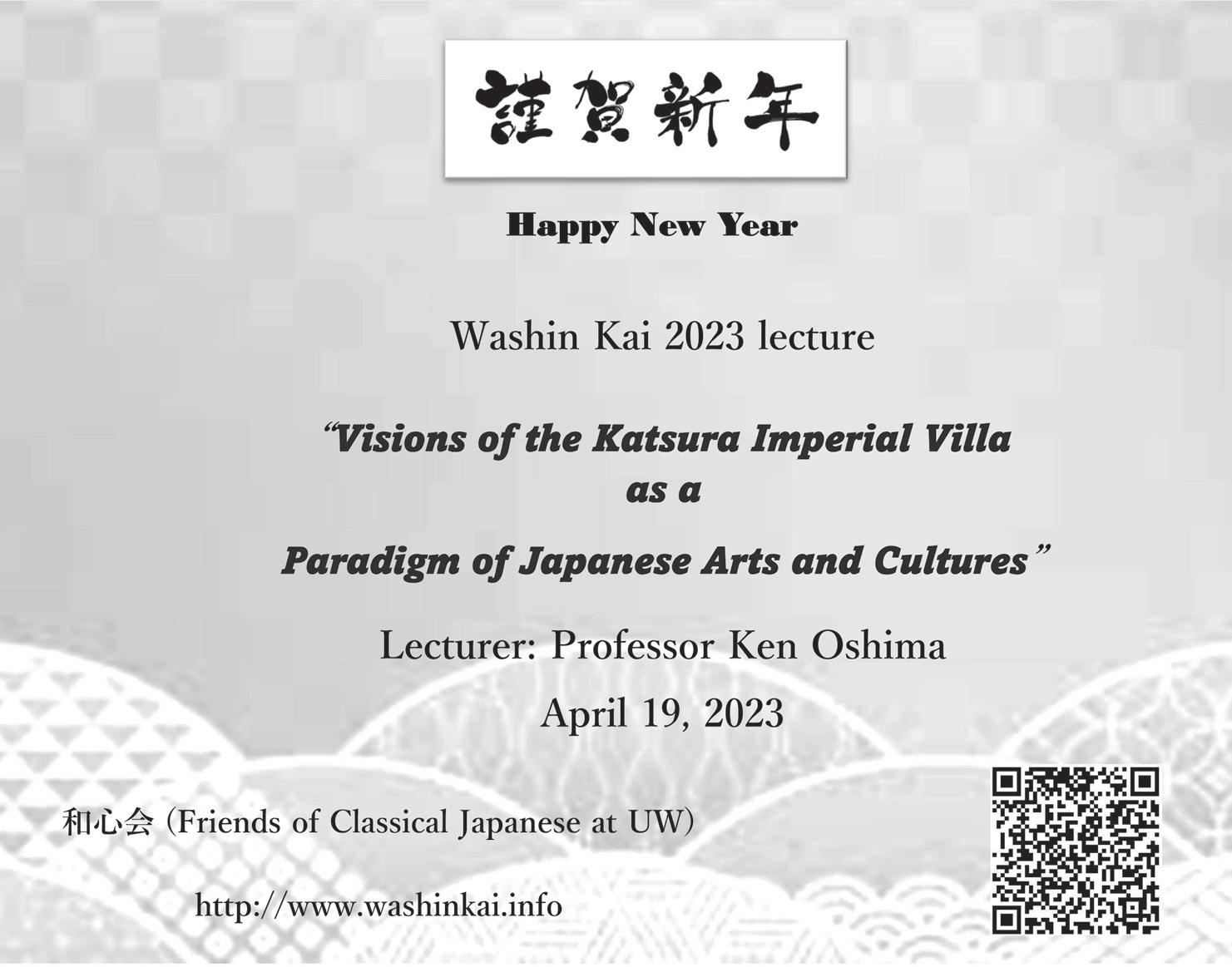
“Amerika dake de dekimashita. Nihon dewa dekinakata.”
“Only in America was this possible... I could not have done it in Japan.”
This was why she was so proud and happy about becoming a U.S. citizen.
Editor’s notes. Haruko was a rare “Issei 1.5,” who immigrated to the US with her parents at age 12 in 1919 (“The Uwajimaya Parking Lot,” napost.com). Thus, she possessed one key advantage over other Issei hotel owners: she arrived young enough to more easily pick up English as a second language. This learning capacity falls rapidly after age 18. Nonetheless, her lifetime accomplishments remain impressive.
8 The North American Post Vol. 77 Issue 24 January 1, 2023 napost.com VOICES
An Overview History of the North American Post, Part 3
By Edward Echtle For The North American Post
Editor’s note. After a long lapse, we continue this series here, left off on Sept. 16 (napost.com). This part is probably the most interesting to readers thus far; it reveals what was happening behind the scenes at the Post from the early 1960s to the late 1980s, a period that many would remember.
“Century 21”
The early 1960s saw increasing cultural and economic exchanges between Washington State and Japan as Seattle’s Nikkei population reached 11,000. Of major interest to the Post’s readers was the four-day visit by Japan’s Crown Prince Akihito and Princess Michiko to Seattle (Misa Murohashi, “Japanese Imperial Visit in 1960,” napost.com, June 2020).

Near the end of 1960, editor Haruo Hashiguchi passed away and the Post’s staff went through another shakeup with Takami “Tak” Hibiya becoming editor and Terumitsu Kano leaving to take a public relations and marketing position with Japan Airlines. (See Kazue Ito and Michele Fujii, “Reprinted Articles from ‘The North American Post,’ Biographical Articles on Former NAP President Takumi Hibiya,” napost.com, July 2022).
One promising addition to the Post’s writing pool at this time was UW student Hitomi Kunimi. Born in Japan, she had worked as an interpreter for US Vice President Richard Nixon and his wife, Pat, during their 1953 trip to the island nation. Afterwards, the Nixons helped her secure scholarships to attend UW. She later married Post staffer Kiyoshi Jitodai and contributed articles to newspapers in Japan as well as to the Post.
In 1962, Seattle hosted the “Century 21” World’s Fair, featuring cultural displays and exhibits from countries around the world. In its coverage of related events, the Post paid special attention to its “Japan Week” in late July, recounting the festivities in detail
as fairgoers enjoyed displays of Japan’s traditional arts and dance, as well as exhibits highlighting Japan’s technological advancements and growing importance as an economic trade partner. Many local Nikkei participated in the exhibitions and were featured prominently in the pages of the Post.
Throughout the 1960s, the Post carried on, despite declining readership, a shrinking staff and occasional setbacks such as a 1964 fire in the hotel above its Fifth Avenue newsroom. Although the fire never reached the Post, water damage made meeting its next deadline a challenge.
Small stories of community interest remained the paper’s mainstay, such as occasional visits from Japan’s Maritime Self-Defense Force training sailingship, or the paper sponsoring a Go tournament in partnership with Seattle’s Go Club. Throughout, the paper remained a key source of important news in Japanese such as the passage of the Immigration Act of 1965, which ended restrictive quotas on Asian immigration, as well as Washington State’s repeal of its 1921-1923 Alien Land law in 1966. Both were welcome news to the generations of Nikkei who had endured those restrictions.
1970s
By the early 1970s, outmigration from Nihonmachi and a declining readership made the Post’s future increasingly uncertain. In a 1973 article, the “Seattle Times” reported that the Post struggled to meet deadlines and generate revenue with its small staff and increasingly antiquated equipment. (See many recent articles on the NAP’s historical printing equipment, including David Yamaguchi’s “Old NAP Printing Press Resurfaces, napost.com, Dec. 2020, and “The Print Quality of the Olde NAP,” Jan. 2022).
The staff shrank to 15, still led by editor Takami Hibiya and assistant editor Dick Kanaya, who were also the principal writers. The balance of the staff worked in ad sales, in subscriptions, or in printing production and distribution. Despite budget-cutting, revenues often fell short of costs due to unexpected

Above:
Photo: Densho: Hibiya Family Collection.
Below: The “Niko Niko Boy” (happy boy), an original hardwood-carved ad, used to advertise Uwajimaya exclusive products during its printing–press era.
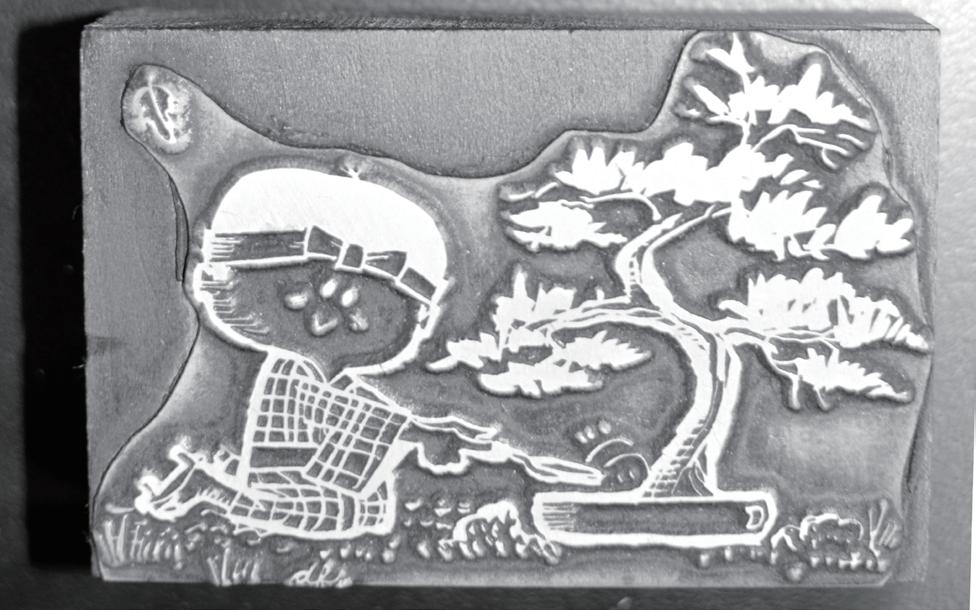
According to Tomio Moriguchi, “father started this logo for the Uwajimaya rice label… We used the boy in many of our ads.” This ad is about 3 inches across.

Photo: David Yamaguchi continued on page 20
expenses such as the Post’s need to relocate due to the impending demolition of the building. Such emergencies regularly required owner H.T. Kubota to make up the shortfall. For his community efforts,
9 The North American Post Since 1902 napost.com
Editor Takami Hibiya’s press pass to the Seattle World’s Fair “Century 21 Exposition” at the Seattle Center.
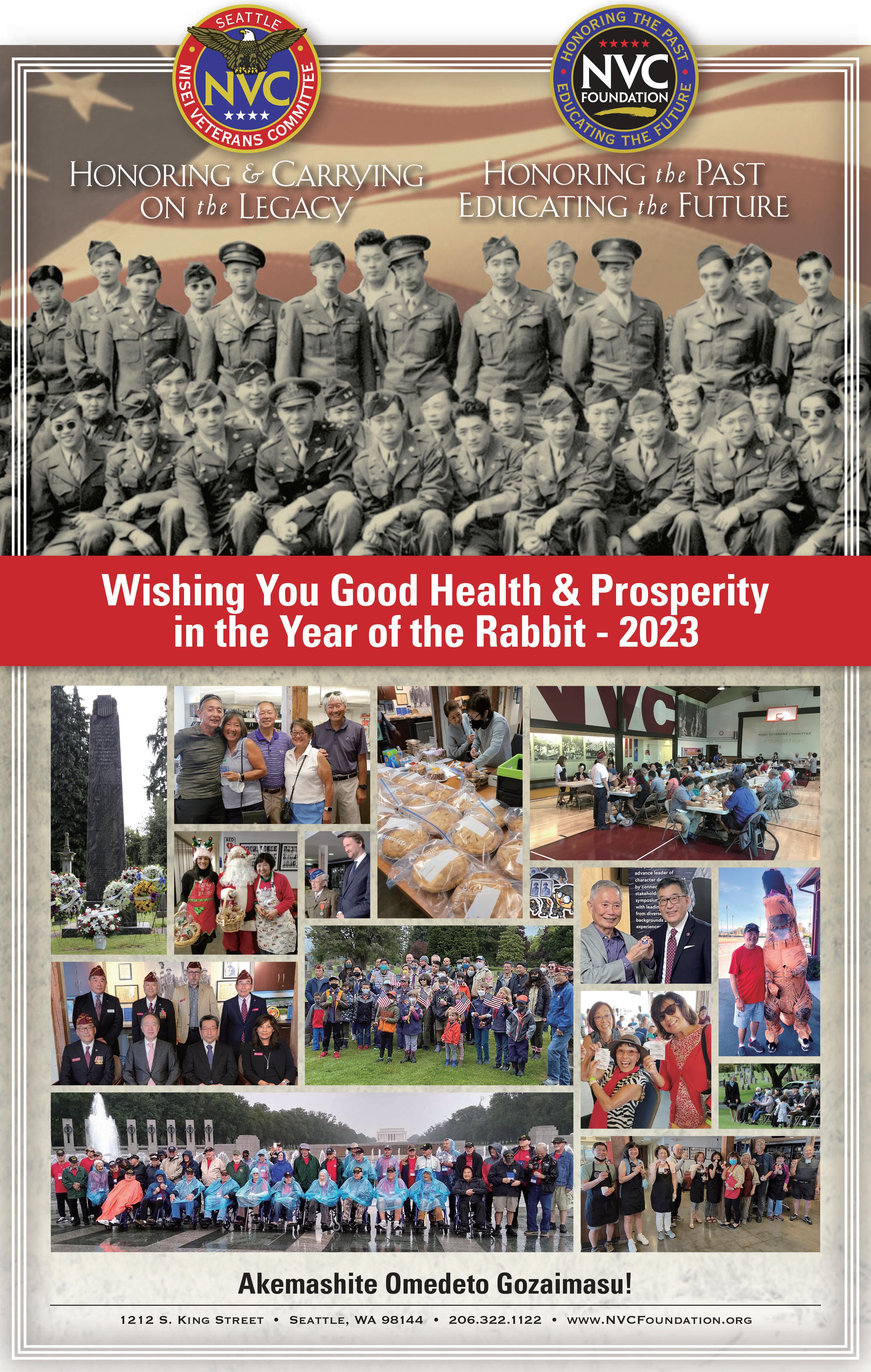
State Legislature
Olympia, Legislative Building WA 98504-0482
NVC Foundation NVC Memorial Hall
Dear Friends,
Akemashite omedeto gozaimasu! Happy New Year greetings to all! On this auspicious occasion, we offer our heartfelt wishes for good health and happiness to the faithful readers and the dedicated staff at the North American Post (Hokubei Hochi).

As the voice of the Nikkei Community in the Pacific Northwest since 1902, the North American Post is a vital institution that keeps us informed about the news and issues affecting us locally, nationally or internationally. This critical service helps to knit a strong bond among the different generations of Nikkei, whether born in Japan like our parents or grandparents, or born in the United States. This offers each of us the opportunity to appreciate the breadth and the richness of our collective perspectives as well as of our common cultural heritage. We are proud to recognize the North American Post (Hokubei Hochi) as a treasured community resource that continues a long and venerable tradition of strengthening and unifying Nikkei throughout the Greater Northwest.
May this spirit of community be the hallmark of the New Year and may the North American Post (Hokubei Hochi) serve as its beacon throughout 2022! Sincerely,
Greetings!
1414 S Weller St. Seattle, WA 98144 www.jcccw.org
Dear Family and Friends of the “J”, Akemashite Omedeto Gozaimasu! Happy New Year to all! 2022 has been a challenging year as we strive for normalcy – living with COVID-19, inflation, and other external factors. Yet, with your support, and a lot of blood, sweat and tears, we have had a year full of successes. This past year we were able to do the following:
• Launched our updated website www.jcccw.org
• Our new principal, Taeko Shu-Sensei, leads our premier program, Seattle Japanese Language School with 11 teachers, 22 classes (in-person and online) and reaching 200+ students
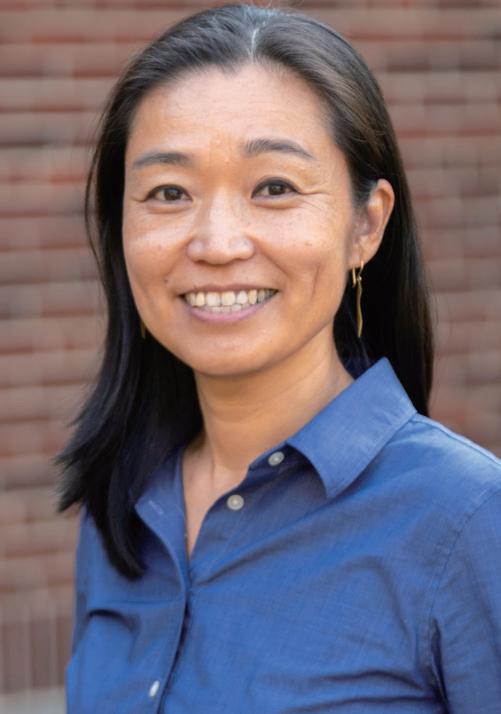

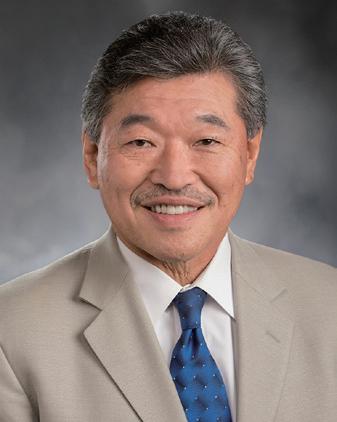

• Interest continues to grow in our adult prep classes for those studying for the Japanese Language Proficiency Test (JLPT)

• Public mural dedication of “We the Ancestors” by local artists Erin Shigaki and Kenji Hamai-Stoll located on our west facing (Rainier) wall
• Increased our in-person events: “All Things Japanese Sale” (550 visitors), “Kodomo no Hi” (Children’s Day - 400 guests) and “Bunka no Hi” (Culture Day – 800 guests)
• Hosekibako resale shop is thriving, and our online shopping service continues to grow – all proceeds support the operation of the ”J”

• Our Monthly Northwest Nikkei Museum Speaker Series has been a big success and our Japanese spoken series “Meet the World War II Camp Survivor” attracted 100+ guests globally – 50% of the audience joined from Japan
• Many of our community classes are back in-person and in full swing: Judo, Karate, taiko, etc. While we continue to adapt to the new norm, we are fortunate to have a great staff, volunteers and community. We hope you are healthy and wishing everyone a safe and Happy Holiday Season and a big thank you for your continued support!
Kurt Tokita Board President
 President
President
The NVC and NVCF express our deep gratitude for your support, partnership, collaboration, and opportunity to educate and share the extraordinary legacy of the Japanese American service member who served during WWII.

The country is beginning to recover from the lingering medical and social effects of COVID-19, and we are changing too. Our monthly meetings transitioned from pure virtual to in-person ones while continuing to broadcast the meetings. The NVC Memorial Hall complex incorporated some much-needed security fencing and gates to protect better our members, volunteers, visitors, and guests. This costly investment has been an overwhelming success. We’ve traveled outside the local area (e.g., the National Character and Leadership Symposium at the US Air Force Academy, and the speaker series at the Rocky Mountain Museum of Military History, Fort Missoula, MT) to promote our mission. We held our 77th consecutive Annual Memorial Day service at Lake View Cemetery after a two-year absence. We’ve stayed busy and relevant thanks to all of you!
The Nisei experience inspires us, and we’ll continue to overcome and adapt to a new normal. The challenges attributed to COVID and an uncertain local and world economic outlook will only dare us to persist and endure in our mission through our programs and services.
Akemashite omedetuō gozaimasu as we enter the Year of the Rabbit. Michael J. Yaguchi, Lt Col, USAF (ret) Geri Lynn Nakao Egeler Commander President Nisei Veterans Committee NVC Foundation

S King Street Seattle, WA 98144 (206) 322-1122 Dear Friends,

3010 77th Ave SE, Suite 102 Mercer Island, WA 98040 (206) 374-0180 jassw@jassw.org
Happy New Year from the Japan America Society of State of Washington (JASSW). 2023 is a very special year for JASSW because we will be celebrating our centennial. Since 1923, for 100 remarkable years, JASSW has forged friendship and understanding between the people of Japan and Washington State. Despite the conflicts the US and Japan faced during and after WWII, JASSW continued its mission. Overcoming these difficulties, we have come together as people with more similarities than differences. We have been working together through economic difficulties and growth, and through crisis and times of abundance. By sharing our culture, arts, sports and our dreams, the US and Japan have grown closer to the benefit of both countries and, I believe, the world. I’m delighted to be part of the Japan-America Society of the State of Washington to continue building the bridge between Japan and America for peace in the world.
Building Community at the grassroots level in an exchange of ideas and cultures and creating positive experiences towards a mutual understanding is an ongoing collaboration in which we all can participate. We do this through programs in classrooms and boardrooms, and lively discussion with community partners and in-person/virtual opportunities to learn from and celebrate each other. We participate in the national network of JAS organizations to sustain and strengthen the vital U.S. – Japan relationship. It is an important mission with lots of fun and memorable moments.
Be a part of the Society and help shape the next 100 years of the Japan-America relationship. Your support will help guarantee we continue to be a resource that creates educational, cultural, business, and a host of other opportunities for our communities here, and across the Pacific. Please join us and celebrate the Society’s remarkable 100 years and let’s continue to Build Bridges to the Next Century.
Shoko Farmer 2022-2023 Chair
Densho
The Japanese American Legacy Project
Dear friends,
Since stepping into my new role as Executive Director of Densho, I have felt so grateful for the warm welcomings I’ve received from this community. I deeply appreciate the generosity of all who have taken the time to meet with me, shared their knowledge and insights, and discussed ways to work together.
I spent the first two months at Densho transitioning into this role under the mentorship of Founding Executive Director Tom Ikeda. Together, we’ve had many rich conversations about the future of Densho. While we talked a lot about change, what I know will remain unchanged is the ongoing importance of Densho’s work — to preserve and share stories of Japanese American WWII incarceration so that this history is never forgotten and never repeated.


1416 S. Jackson St. Seattle, WA 98144 https://densho.org/
We will continue to provide extensive resources, educational materials, and public programming as we have always done. We will continue to actively seek out those stories that require surfacing to create a fuller picture of the Japanese American wartime experience. And we will continue working to ensure that materials surrounding this important chapter in history are not just accessible but that our community’s histories are reflected in what young people are learning about our nation’s past.
A stronger understanding of our history can empower us to transform our schools, our neighborhoods, and our communities into more equitable and welcoming spaces. And I’m excited — and humbled — for the opportunity to undertake this important work with all of you.
With warm wishes for a happy 2023,
11 The North American Post Since 1902 napost.com
Washington
新年明けましておめでとうございます。
Nisei Veterans Committee
1212
Sharon Tomiko Santos Washington State Representative 37th Legislative District
ワシントン州日本文化会館
Bob Hasegawa Washington State Senator 11th Legislative District
Japanese
Cultural & Community Center of WA
Japan Business Association of Seattle (Shunju Club) シアトル日本商工会(春秋会) 919 124th Ave. NE, #207, Bellevue, WA 98005 (425) 679-5120 明けましておめでとうございます。皆さま健やかに新春をお迎えの こととお慶び申し上げます。 旧年中はシアトル日本商工会(春秋会)の活動にご支援、ご協力を 賜りまして、誠にありがとうございました。商工会を代表いたしまし て厚く御礼申し上げます。 各種活動の規制緩和が始まり、地域の皆さ まとの対面行事が再開できましたこと、大変喜ばしい限りでございま した。 本年は各種活動の更なる再開、役に立つ情報発信やウェビナーの開 催等、地域社会に根付いた活動を通じて、皆さまとの交流をより深め ていきたいと願っております。 シアトル日本商工会(春秋会)は会員や地域社会にとりまして魅力ある存在であり続けるよ う、絶えずまわりのお声に耳を傾けながら、新しい企画に挑んでまいります。今後とも変わら ぬお力添えを、どうぞよろしくお願い申し上げます。 2023 年が皆さまにとって、幸多き1年になりますよう祈念いたしております。 令和5年(2023年)元旦吉日 シアトル日本商工会(春秋会)会長 安藤 威
Kurt Tokita Board President
Takeshi Ando
Naomi Ostwald Kawamura
Naomi Ostwald Kawamura Executive Director
By NAP
Seeking “Minidoka Matinee” Recordings
History researcher Roy Baugher is seeking surviving recordings of “Minidoka Matinee,” a radio program that was produced and performed by Japanese American incarcerees of Minidoka during January-April 1945.
According to the “Minidoka Irrigator” newspaper and other sources, audio recordings were made of the program’s live broadcasts. One goal of the current project is to determine if these audio recordings exist and to find them.

If recordings of the program exist, then they are most likely on “transcription discs,” which are similar to vinyl records. Transcription discs were either 16- or 12-inches in diameter.
Baugher is interested in contacting any “Minidoka Matineers” who are still living and their families about the radio program to find out if they remember anything about the recordings being made.
He is “especially interested in contacting the families of Hero Nishimoto or Ted Shimano, since both were the main contributors to the radio program. Nishimoto was the show’s announcer and a producer.
Shimano was the orchestra’s music director and conductor.” Both men are noted in the WRA records as being from Seattle before incarceration.
Other participants, mentioned in the “Irrigator,” were also mostly from Seattle. A few were from Auburn, Olympia, Vashon Island, Washington, and Portland, Oregon. They are Dorrie Abe, Nora Hoshi, Amy Iguchi,




“Minidoka Matinee” Orchestra, 1945.
Densho, Bain Collection. The Densho caption reads, “Left to right: Joe Owaki (drums), Hiro Nishimoto (MC), Dorrie Abe (piano), Ted Shimano (orchestra conductor), Amy Iguchi (clarinet), Yosh Ogata (saxophone), George Kaku (violin), and Sally Makishima (violin). The residents of the Minidoka concentration camp formed numerous musical ensembles to pass the time. Orchestras, bands, and choirs frequently staged performances for entertainment.

Chickie Ishihara, George Kaku, Kit Kitayama, Kaz Kubo, Sally Makishima, Mariye Morimoto, Mary Nakata, May Natsuhara, Porky Noritake, Yosh Ogata, Yosh Okihara, Joe Owaki, Jack Teraoka, Marion Unosawa, Phyllis Unosawa, Sachi Uyegaki and Mitsu Yasuda.
Further info:
Roy Baugher may be contacted at: cbawcd@gmail.com.

Background on his recording project may be obtained from his article, “Minidoka Matinee: Japanese Americans on the Air,” Association for Recorded Sound Collections (ARSC) newsletter, no. 160, p. 4, arsc-audio. org/newsletter.html
Above: Jake Shimabukuro played for one night at the Moore Theater on Dec. 10.

Right: The Christmas star shines on the old Bon Marche building in downtown Seattle, now occupied by Uniqlo.Though the juxtaposition of its corporate logo with the Christian star doesn’t make sense, the Japanese clothing company deserves credit for moving into the grand old building and helping preserve it.

Spaces Open for May 2023 Japan Tour
 By Elaine Ikoma Ko For The North American Post
By Elaine Ikoma Ko For The North American Post




“The North American Post” is pleased to announce the restart of its popular group tour to Japan set for May 10-23, 2023! The tour will travel to many of the top attractions in Tokyo, Yokohama, Takayama in Gifu Prefecture, Kyoto, Osaka, Kobe, and Hiroshima. Already largely filled by past participants, as of this printing, we have three spaces open.
This a walking tour with transportation on the local bullet trains, subways, and trains. The cost


12 NEWS
The
Photo:
Deposits are due soon, so act quickly. For more information, contact:
Downtown
The Shibuya Scramble, used to establish the setting in Japanese movies. Photo: Sei F, CC BY-SA 2.0, wikimedia.org
Stars
ASTROLOGER CAN REMOVE BLACK MAGIC, JADOO, EVIL SPIRITS, ZIN, VOODOO, OBEYA AND ANY KIND OF NEGATIVE ENERGY REMOVE & GIVES PROTECTION All are Heartly welcome Call for Appointment SPECIALIST IN BRINGING BACK LOVED ONES. NOTE: He is a member of the Indian Council of Astrological Services PANDITH SAI GURU 4253709676 Do you have Problems Do you have Problems Do you have Problems he has Solution he has Solution he has Solution Specialist in Bringing Back Loved Ones Specialist in Bringing Back Loved Ones Specialist Bringing Back Loved Ones Family-Marriage Health Anxiety& Depression Business Relationship Negative Energy # 1 4 6 6 0 N E 3 1 s t w a y , B e l l e v u e , W A 9 8 0 0 7
Photos & text by David Yamaguchi The North American Post
A star shines in the Northwest.


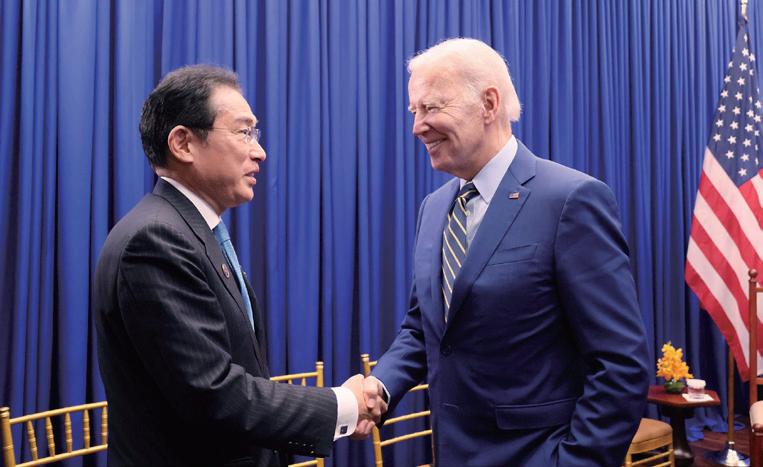






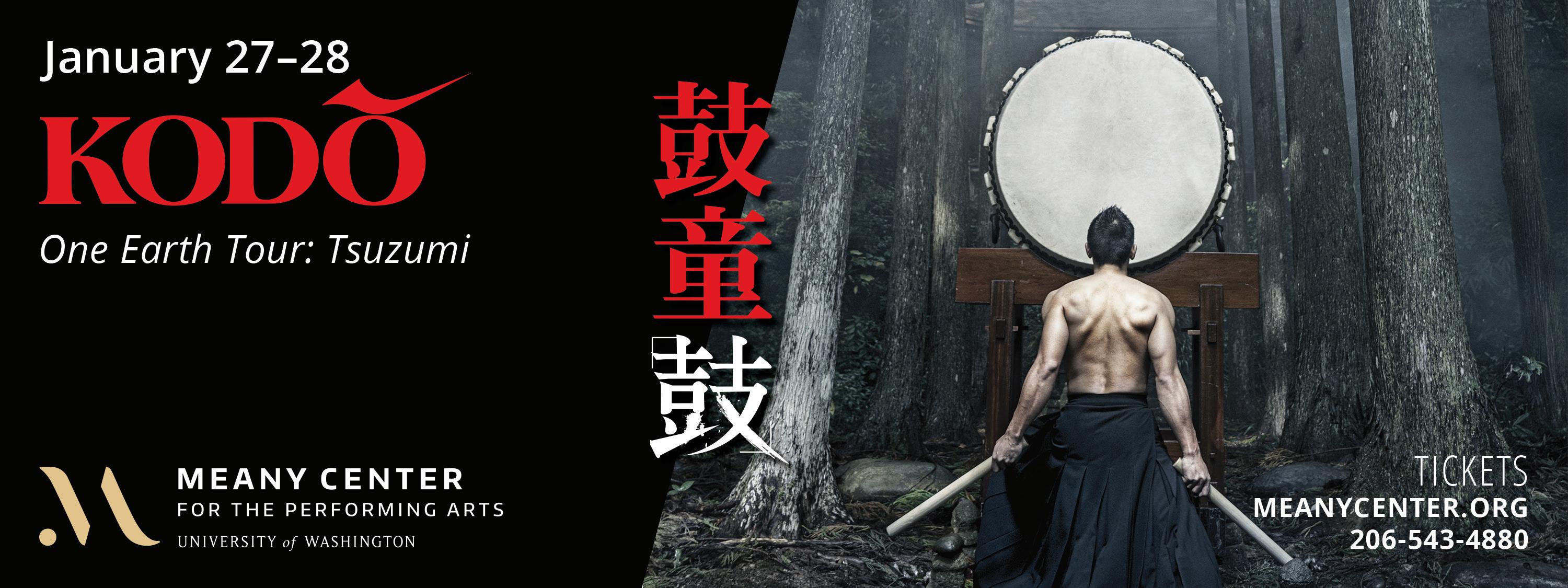
The North American Post Vol. 77 Issue 24 January 1, 2023 napost.com 日米首脳会談 令和4年11月13日、ASEAN関連首脳会議出席のためカンボジア王国を訪問中の岸田文雄内閣総理大臣は、ジョセフ ・バイデン・アメリカ合衆国大統領と、日米首脳会談を行いました。その概要を北米報知の読者の皆様へお伝えいたしま す。アメリカ合衆国在住の皆様におかれましては、両国の友好関係が一層強化されていくよう、引き続きお力添えをお願 い申し上げます。 日米首脳会談 冒頭、両首脳は、ロシア によるウクライナ侵略、北朝鮮の度重なる挑発行動、 東シナ海・南シナ海における力による一方的な現状変更の試みの継続等により、 我々を取り巻く安全保障環境は厳しさを増しているとの認識を共有しました。その上で、両首脳は、強固な日米関係が地域及び国際社会の平和と安定に果たすべき役割は大きいとの認識を共有し、日米同盟の抑止力・対処力の一層の強化を図るとともに、「自由で開かれたインド太平洋」の実現に 向けた取組を推進し、地 域 及び国際社会の平和と繁栄を確保すべく日米で協働していくことで一致しました。 両首脳は、地域情勢につ いて、次のとおり意見交換を行いました。 ( 1) 両首脳は、中国を めぐる諸課題への対応に当たり、引き続き日米で緊密に連携していくことで一致しました。また、両首脳は、 地域の平和と安定の重要性を確認しました。 ( 2) 両首脳は、北朝鮮 による前例のない頻度と態様での弾道ミサイル発射は断じて容認できないことで一致した上で、国連安保理決議に従った北朝鮮の完全な非核化に向け、引き続き日米、日米韓で緊密に連携していくことを確認しました。また、岸田総理大臣か ました。 ( 3) 両首脳は、ロシア によるウクライナ侵略について、引き続き G 7 を始め とする同志国と結束して、 強力な対露制裁及びウクライナ支援に取り組んでいくとともに、グローバル・サウスへの働きかけを強化していくことで一致しました。 また、両首脳は、ロシアによる核の脅しを深刻に懸念しており、断じて受け入れられず、ましてやその使用は決してあってはならないことを確認しました。 続いて、岸田総理大臣か ら、日本を取り巻く安全保障環境が一段と厳しさを増 す中、 2 0 2 2 年末までに 新たな国家安全保障戦略を策定すべくプロセスを進めている旨述べ、我が国の防衛力を抜本的に強化し、その裏付けとなる防衛費の相当な増額を確保する決意を改めて示したのに対し、バイデン大統領から、力強い支持を得ました。 次に、両首脳は、 I P E F (インド太平洋経済枠組み) 及び経済版「 2+ 2 」に係る 進展を歓迎するとともに、地域の経済秩序や経済安保に対する米国の関与がますます重要となっているとの認識を共有し、岸田総理大臣から、戦略的観点を踏まえ、米国の早 T P P 復帰を改めて促 しました。また、岸田総理大臣から、米国による環境配慮車両への優遇措置に対する我 が国の考えを伝達しました。 そして、両首脳は、 2 0 2 3 G 7 広島サミッ トの成功に向けて、引き続き日米で緊密に連携していくことで一致しました。 日本国政府(写真提供・ 内閣広報室) より詳しい情報は、首相官邸ホームページ(http:// www.kantei.go.jp/)、外務省ホームページ(http:// www.mofa.go.jp/mofaj/)をご覧ください。 また、日本政府の政策や日本の魅力について、英文 の日本政府公式ホームページ「JapanGov」(http:// www.japan.go.jp)や、英文オンライン・マガジン 「HIGHLIGHTING
もご参照ください。 この記事に関するご意見・ご感想は下記までお寄せ ください。 内閣府大臣官房政府広報室 Public Relations Office, Cabinet Office, Government of Japan E-mail:
日米首脳会談 日米首脳会談
Japan」(和文も掲載。https://www. gov-online.go.jp/eng/publicity/book/hlj/index.html)
g.kaigai@cao.go.jp
Year of the Rabbit Drawings by Seattle Japanese Language School Students

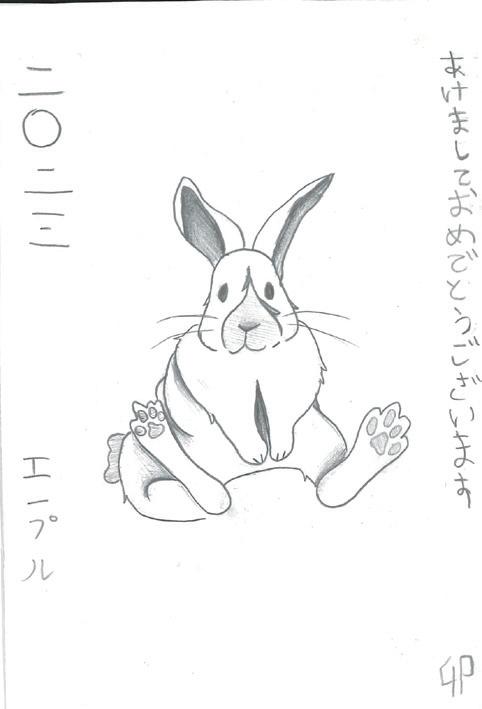


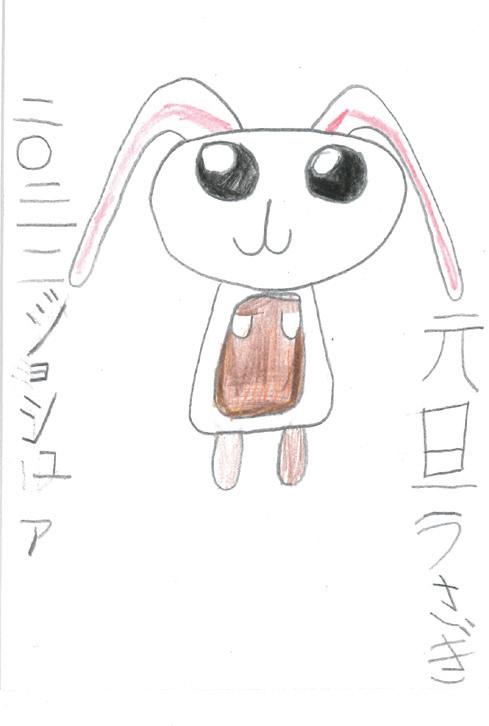




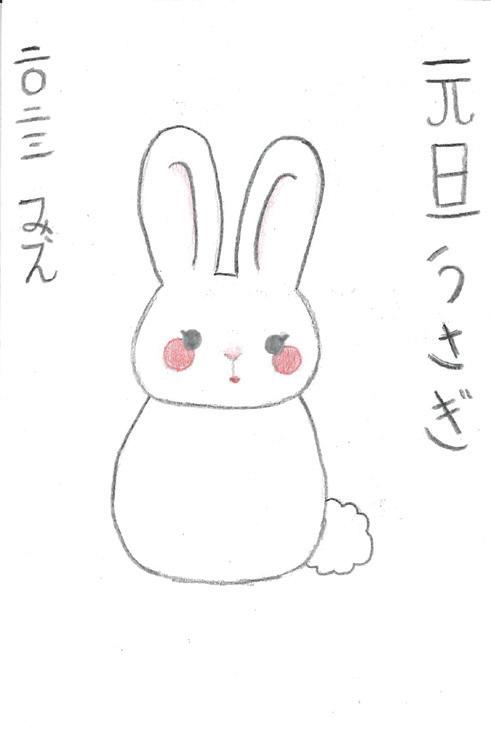
More New Year's illustrations from Japanese Language School students will appear in the January 13th issue.
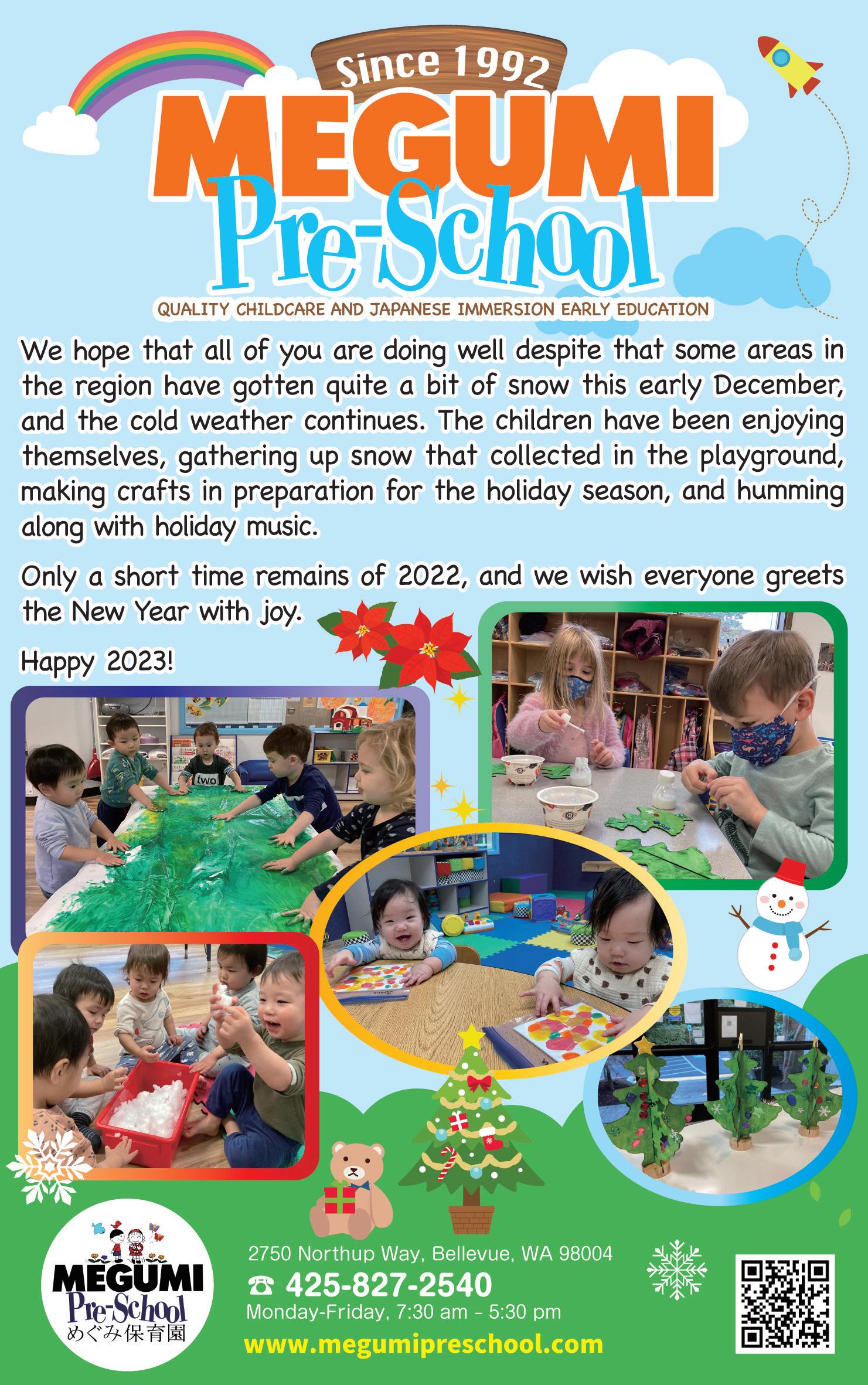
▲ By Kyoko Constantine, 8 years old
▲

▲ By Miye Yogi-Adams, 9 years old

◀ By Phoebe Kensler, 10 years old ▲ By Amaile Brenner, 10 years old ▲ By Apple Lee, 13 years old ▲ By Cailan Balboa Sanchez, 9 years old ◀ By Etienne Fredieu, 12 years old
▲ By Joshua Buchanan, 10 years old ▲ By Satomi Jules Giedman, 14 years old
By Ethan Schaps, 12 years old
15 The North American Post Since 1902 napost.com Japanese
of
ワシントン州日本文化会館
Cultural & Community Center
WA
Seattle Japanese American Citizens League
P.O. Box 18558 Seattle Wa 98118 http://seattlejacl.org info@seattlejacl.org
Membership: https://jacl.org/member/
The Seattle Chapter of the Japanese American Citizens League (JACL) wishes you and all North American Post readers a very Happy New Year! The year 2021 was filled with challenges to health, work, travel, social justice, and political discourse. When confronted with the many ups and downs, we persevered.
Through it all, the North American Post continued to chronicle news, events, and passages within the Seattle Japanese American Community as a respected voice of and for Japanese Americans in the city, county, and state. We value and appreciate your continued coverage throughout the turbulent times of the past two years. We know it’s been hard. Please know you have our continued support!
Seattle Chapter JACL reached its 100th anniversary in 2021, but given the COVID-19 pandemic, our centennial celebration was curtailed and postponed, so it will continue in various forms in 2022. Stay tuned!
Seattle JACL continued to adjust to the COVID-19 environment in 2021, producing a series of online workshops around Multi-Racial Identity and continuing our series on Anti-Blackness in the Japanese American community. We completed production of a nine-panel “pop-up” history of the Seattle JACL, continued our fight against Anti-Asian Hate, and awarded $21,000 in student scholarships to youth attending college and graduate school. And we supported immigrants fighting incarceration, deportation, and family separation.
As we enter the New Year, Seattle JACL will continue to work on issues of racism and equity, identity and culture, history and legacy, civic engagement, student scholarships, youth leadership training, and social justice. We invite your readers to join us in 2022!
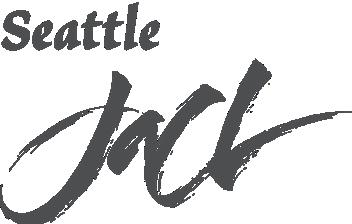
Puyallup Valley Chapter of the Japanese American Citizens League

Akemashite omedetou!
Members of the Puyallup Valley JACL wishes everyone in our communities a safe, healthy, and merry holiday season. While the availability of the Covid vaccine has opened up some of our in-person activities, we must still be careful and vigilant. We want to enjoy everyone in the new year.
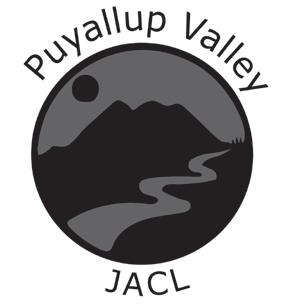
11415
234th Place Kent, WA 98031 www.puyallupvalleyjacl. orgelamphere@live.com
Puyallup Valley is partnering with the Washington State Fair, formerly the Puyallup Fair, to create a name marker to acknowledge and honor all the families and individuals who were imprisoned at “Camp Harmony.” The 2022 fair season will be the kick-off for this community effort to develop the legacy of the only concentration camp in Washington State. This tribute will not be a Puyallup Valley effort or a Japanese American effort, but an American community effort.
This year the chapter joined the Puyallup Arts Downtown to dedicate a sculpture to the City of Puyallup’s Sculpture Park. Seattle Matsuri and Fuji Taiko performed before, during, and after the program. Puyallup Mayor Door accepted this gift from Becky Condra or the Arts Downtown. The event featured John Zylstra, artist, who shared his inspiration and message. Cho Shimizu recalled his days living on the fairgrounds, while Lori Matsukawa connected this piece of work to the larger incarceration experience. Kent Hojim, Fair CEO, provided the connection of the current fair to the military camps during WWII.
With the coming of a new year, we look forward to celebrating a safer and healthier 2022.
Happy New Year!
Eileen
Yamada Lamphere, President

Seattle Betsuin Buddhist Temple 浄土真宗本願寺派 シアトル別院
3625 Auburn Way N, Auburn, WA 98002 (253) 833-1442
I am White River Buddhist Temple’s (WRBT) new resident minister, Rev. Cyndi Yasaki. I have just been assigned to the temple late last year, so I look forward to meeting everyone and working to help spread the Dharma to any who wish to hear it.
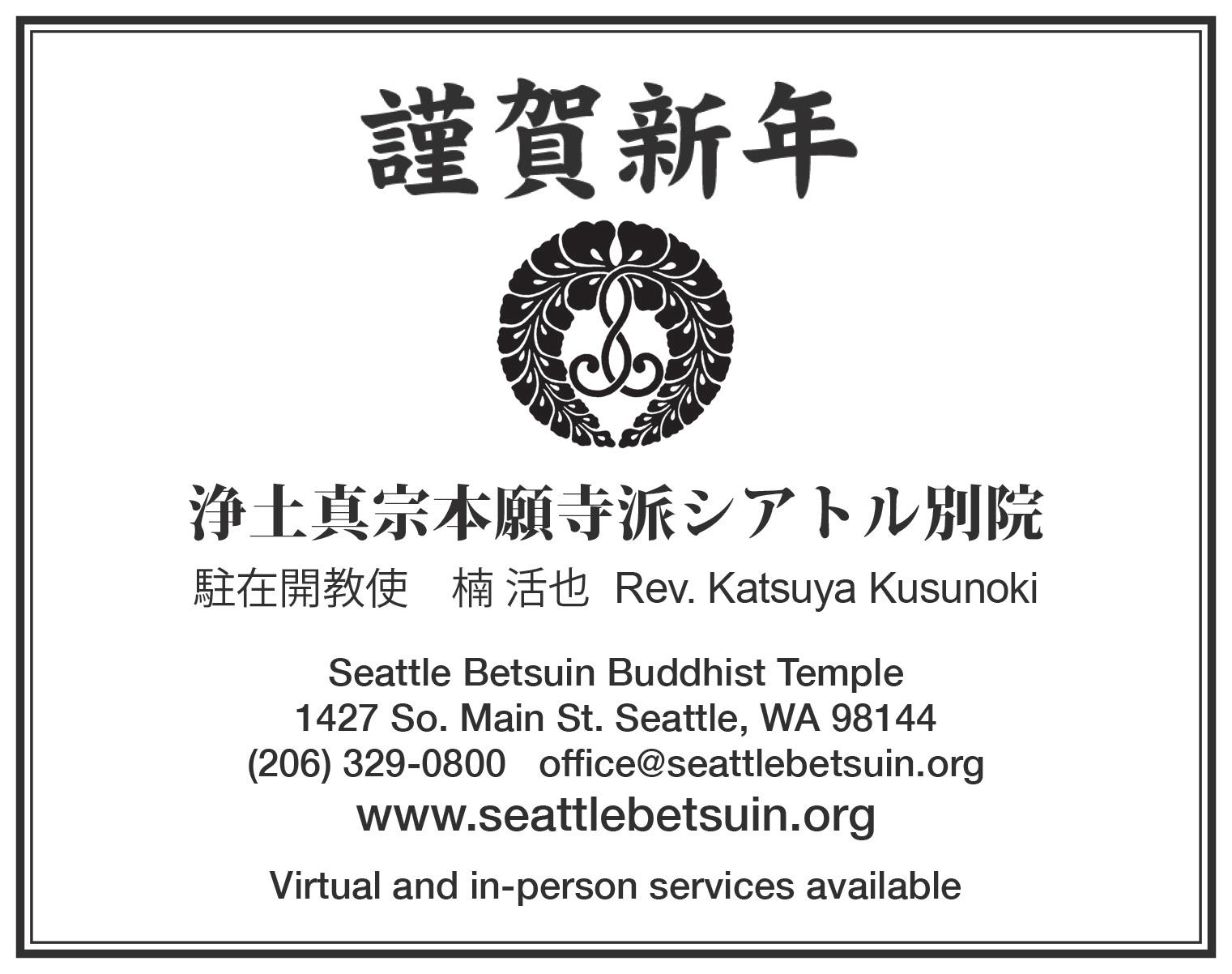

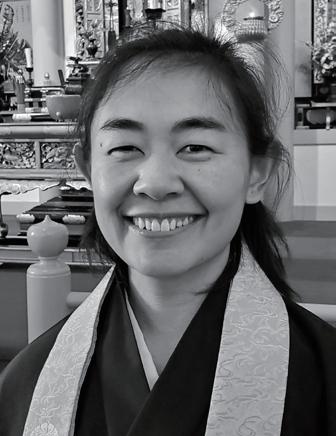
As WRBT opens up, 2023 will become a year steeped in interdependence with the surrounding community. Interdependence is the Buddhist concept that all beings are connected in some way. This past year, the temple not only started to conduct services every Sunday, but also hosted events that helped the surrounding community like cooking food for the shelters and having Covid tests and vaccines available for everyone.
In 2023, WRBT will continue to hold services every Sunday and will hope to start opening our doors for more community events. Events we hope to host next year include our Spring plant sale, our delicious food bazaar in October and our famous and highly anticipated Obon festival in July. Please look forward to these events and more as we continue to work with the surrounding community to create a safe space centered around the Buddha’s teachings.
With palms together, Rev. Cyndi Yasaki
1427 S Main St, Seattle, WA 98144 (206) 329-0800
生活に戻ってきたように思いますが、皆さんはどのようお過ごしでしょう か。お寺では、2022年4月より対面のお参りが再開され、お寺に少しずつ 活気が戻ってきました。出張でほかのお寺やカリフォルニア州へ行くこと も増えました。それと同時に、オンラインでの活動も続いています。会議 や勉強会はオンラインで開催されており、日曜日のお参りなどはハイブリ ッドという形で行われています。テクノロジーのおかげで便利になったの は間違いありませんが、なにか前よりも忙しくなったのでは、とも感じま す。
“忙”という字は、心を亡くす、と書きます。忙しくなると時間に余裕が なくなり、心にも余裕がなくなります。それが続くと、心がむしばまれ病気になっていくのでしょう 。新型コロナの影響が無くなっても、私たちの心が病気になってしまってはいけませんね。皆様が 、一日一日、心にゆとりをもって、心身ともに元気にこの1年を過ごされることをお念じ申し上げ、 新年のご挨拶とさせていただきます。 合掌
On behalf of the Seattle Betsuin Buddhist Temple, I wish each of you a happy and healthy new year. Most COVID restrictions have been lifted. People are traveling to many places. Life is getting back to “normal”. Seattle Betsuin Buddhist Temple resumed in-person services in April 2022. The temple is getting back to its lively and full activities. And I have more opportunities to visit other Buddhist temples and to travel to different states on business trips. The temple continues to provide online programs even after resuming in-person services. Meetings and study classes are held online. Sunday services are offered in hybrid. Our life has become more convenient because of improvements in our technology. On the other hand, I also feel my life has become busier.



“忙” is the kanji character of busy. “忙” consist of two parts. The left side means “heart(心)” and the right side means “lose(亡)”. When our life becomes busy, we are pressed for time. We lose room in our hearts to live our lives fully. Eventually, our hearts will be consumed by a busy life and we will become ill. We must be careful about our mental health, as well as our physical health.
I hope that you keep enough room in your heart to enjoy your life each single day in 2023. Please take care of yourself and I look forward to seeing you again. With Palms Together, Rev. Katsuya Kusunoki Rimban シアトル別院 輪番 楠 活也
16 The North American Post Vol. 77 Issue 24 January 1, 2023 napost.com
Akemashite Omedetō Gozaimasu!
NEW YEAR GREETINGS
Stanley N Shikuma, President of Seattle JACL
Stanley N Shikuma
SE
The White River Buddhist Temple would like to wish everyone a Happy New Year!
Rev. Cyndi Yasaki
新年明けましておめでとうございます。2023年もどうぞ宜しくお願い 致します。 新型コロナウイルスの影響で続いていた行動規制もほぼなくなり、元の
White River Buddhist Temple
白河仏教会
Rev. Katsuya Kusunoki
Konko Church of Seattle 金光教シアトル教会





Seattle, WA 98144 (206) 325-4498
Greetings,
Congratulations on your health and happiness throughout the year. Over 160 years have elapsed since the Founder of Konkokyo, Bunjiro Kawate, received the Divine Call, a request from Tenchi Kane No Kami to Bunji to end his farming career and dedicate himself fully to sacred mediation to help people receive teachings and blessings. In North America, we have been blessed to offer this Way of sacred mediation since 1928 when the first Konko Church (Seattle) was established.

The Konkokyo Headquarters recently completed an English translation of the biography of the Founder of the Konko faith, Ikigami Konko Daijin. Learn about the origins of the Konko Faith and the evolution of the Way of Mediation of Ikigami Konko Daijin. If you are curious about the story of how a farmer became the founder of this Way of Faith, come by and receive a copy of this book at the Konko Church of Seattle. For more information, visit http://www.konkofaith.org/churches/ konko-church-of-seattle/seattle-church-news-updates.



I would also like to wish everyone happiness, harmony and good health in 2022. Happy New Year to all!
Sincerely, Rev. Robert Giulietti, Head Minister, Konko Church of Seattle
Tacoma Buddhist Temple タコマ仏教会

A very Happy New Year to the readers of the North American Post. I am very honored to have been asked to write in this paper for the first time. I am still relatively new to the area but have been having a wonderful time learning about the history of Japanese immigrants in the northwest.

While we are beginning to start being able to reconnect and visit with our families again for the holidays and traditional new year’s celebrations or shogatsu, I feel a deep sense of gratitude that I still have many family members I can spend time with and a sangha who shares in the dharma. While many of us may have had to celebrate or ring in the new year in a different manner these past two years, I highly encourage all of us to somehow connect with our loved ones either through Zoom, or phone call if we can’t see each other in person.
1717 S. Fawcett Avenue Tacoma, WA 98402 (253) 627-1417 info@tacomabt.org
If this pandemic has taught me anything, it is that I cannot get through tough and bumpy times in life on my own. My good friend and former minister of the Tacoma Buddhist Temple, Rev. Dr. Takashi Miyaji highlighted the importance of the Buddhist concept of interdependence in one of his previous articles and I continue with that thought. We must rely on one another in times of sadness and hardship and during times of ease and happiness. This is because change and adjusting can be very difficult and turbulent. If we can see beyond our self and acknowledge the support and love from others, we can approach this New Year with a renewed sense of happiness and gratitude.
I wish everyone a safe and healthy New Year!
Reverend Tadao Koyama, Tacoma Buddhist Temple



17 The North American Post Since 1902 napost.com
1713 South Main
Street
Rev. Robert Giulietti
NEW YEAR GREETINGS 新年あけましておめでとうございます。本年も宜しくお願いもうしあげ ます。 一昨年コロナ禍の初め頃、当山でもすべてのサービスをズーム(ビデオ 中継式)と来訪式との併用に切り替えました。パンデミック中はお寺を閉 門しなければならない時期もあり、当初は苦肉の策でしたが、だんだんこ のズーム式の良さが現れてきました。 ローマ、フィレンツェ、ロンドン、シドニー、ベルリン、ウィーン、サン パウロなど、海外から当山のメディテーションに参加する人々が増えてき たのです。そして昨年の2月末には、ウクライナ在住の青年が参禅するよ うになりました。ロシアによる侵攻が始まった頃です。 彼の名はヤン君。26歳。ブッディストネームを和 わぼう 防さんといいます。西 部にある中世以来の城下町ルーツクに住んでいますが、人口20万人のうち 仏教徒は、彼と彼のおばあさんを含めても3、4人だそうです。お父さんはウクライナ正教の聖像 を専門に描くプロの絵師です。それ以降、和防さんとは毎日対話をするようになりました。彼がい なくなってしまうまでに、彼が仏教に求める問いに、できるだけ答えたかったからです。 彼との対話は、私自身にもたくさんの気づきを与えました。いつ何どきミサイルが屋根を破って 炸裂するかもしれない状況下で、いつ何どき我が街が戦火に包まれるかもしれない状況下で、それ でもなお人は、心の成長を求めて仏道に光を探すものなのだ、と。 その後、対話の間隔は週1回になりましたが交流は続き、和防さんが主宰する小さな仏教コミュ ニティーをサポートするために、和歌山の高野山で作ったお香、作務衣、和菓子、そして緑茶、ほ うじ茶などを送りました。多くは高野山の商家の皆さまからのご寄進でした。現在は極寒のなか暖 房が使えないとのことで、カイロを送ろうと計画しております。氷点下の自室から、今も和防さん は当山のメディテーションへ参禅を続けています。 というわけで正直に申しあげますと、ウクライナで戦争が続いている状況で、声高に「おめでと うございます」と言うのは憚られるのですが、和防さんと私の対話の中での或る問答をご紹介して、 新年ご挨拶の締めくくりとさせていただきます。 太定「和防さん、あなたは今なにを一番切実に祈りますか。やはりウクライナがロシアに勝利する ことでしょうか」 和防「いいえ。ウクライナの兵士と市民、そしてロシアの兵士と市民、彼らの心の中に充満する怒 りと憎しみの霧が晴れて、慈悲のまなざしでお互いを見ることができるようになることを祈ります」 本年が皆様にとって良い年となりますように。 合掌 シアトル高野山 主任開教師 今中太定 1518 S Washington St Seattle, WA 98144 (206) 325-8811
Rev. Tadao Koyama
Seattle Koyasan Buddhist Temple シアトル高野山
Rev. Taijo Imanaka
Japantown Banner Project Outreach
backgrounds and generations from our Japanese American and Japantown communities.


Proposed Japantown banners project and timeline with artist Kenji Hamai Stoll. Images: Japantown Neighbors

 By Aya Chiong-Bisbee For The North American Post
By Aya Chiong-Bisbee For The North American Post
Japantown Neighbors would like to share information and receive community feedback about an upcoming project taking place in Seattle’s Nihonmachi. With funding from a Seattle Department of Neighborhoods grant, the Japantown community has come together to develop neighborhood pole banners to honor the legacy of Japantown. There will be about 50 banners installed
on light poles on South Jackson, South Main and South Washington Streets and on 5th, 6th, Maynard and 7th Avenues South. The banners will feature 7-10 unique designs, projected to be installed in late spring 2023.
This project is being directed by Japantown Neighbors, a group of business owners, property owners and community members, in partnership with an advisory committee made up of eight local community members representing different
At this point in the project, there are six draft designs, with room for refinement and more to be developed. Please share your feedback on the draft designs via the form linked below by January 9, 2023. The community feedback received will help inform the final designs to be installed.

Further info on artist Kenji Hamai Stoll: yokenji.net & “New Mural by Erin Shigaki and Kenji Hamai Stoll” (napost.com, Aug. 2022).



View the draft designs and share feedback here by January 9th:
https://tinyurl.com/JapantownBanners










(Those submitting feedback will automatically be entered into a raffle for neighborhood prizes.)

18 The North American Post Vol. 77 Issue 24 January 1, 2023 napost.com
NEWS
Makoto Ogasawara of Sandwich House TRES
By Reika Nishiyama For The North American Post
One day, my friend (who is not Japanese) gave me a sandwich from the TRES Sandwich House.
When I was walking to my classroom, another friend (also not Japanese) pointed to my sandwich and said “I know the shop, I love their sandwiches!”
I shared the sandwich with my Japanese friend and she said, “I miss Japan!”
The shop is run by a married Japanese couple. I wanted to ask them why their sandwiches are so loved by everybody.

“I make sandwiches that Japanese can be confident about eating.”
Interviewing Makoto Ogasawara, one of the founders of Sandwich House TRES and a current manager of the store, I could find his “kodawari,” which means to be particular about, to take something seriously, and to be committed to, in many parts of his stories.
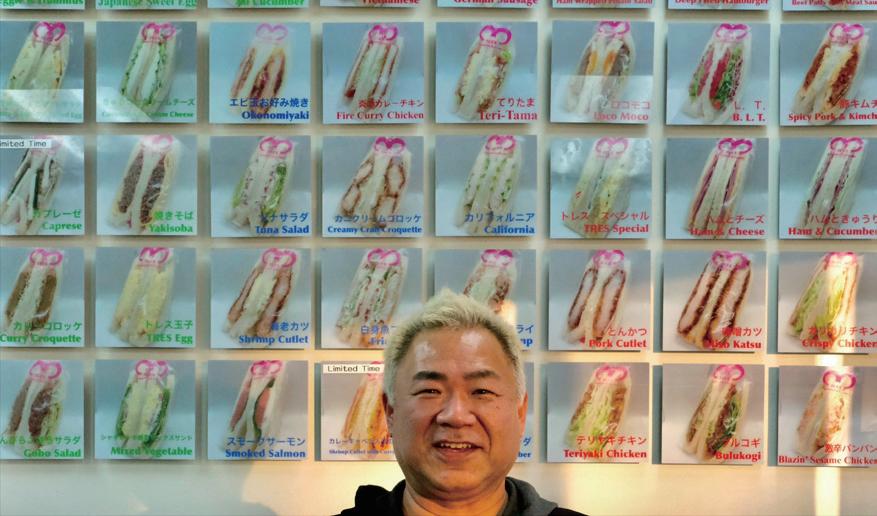
“TRES means three in Spanish, and this represents the triangle shape of sandwiches and three of us who launched this sandwich store in Bellevue. When I came to the US from Japan in 2000, we worked at a tour company for Japanese visitors and international students from Japan. Two of my coworkers started planning to run a bakery in 2014, and I joined them. However, we had not worked in the food industry and did not have any experience making bread from scratch. However, if we opened a bakery, we wanted to have ‘kodawari’ about making the best bread.

“When I started thinking about launching a Japanese bakery, the Sandwich House Meruhen, which is located in several cities in Japan, came to my mind. The taste of the fruit
sandwiches left an impression in my mind, and I thought that if we started a brand new sandwich ‘House’ in the US, people would love to come and eat. We all like to cook and were already good enough at cooking side dishes that would complement sandwiches. I kept cooking and experimenting with the filling ingredients and pursuing ‘kodawari.’ We put a lot of effort into cooking side dishes that Japanese people would also love to eat.
“However, the big problem was, none of us had ever made bread. We explored Asian grocery stores on the West Coast, in Los Angeles, etc., to examine the quality and sorts of sandwiches sold there. Then, we were convinced that we would be able to make higher quality sandwiches.
“We kept experimenting for three months. In the beginning, we asked Fuji Bakery to make our bread. They were very cooperative to pursue our ‘kodawari.’
“In the middle of 2015, a baker in Nagano city invited me to visit his bakery for five days to learn how to make high-quality bread. The bakery was also thinking of expanding its business to Seattle, so we could strengthen our relationship. After the training, we were able to eventually make our bread from scratch and kept using the recipe. When we make our bread, we also need to care about the water. It is said that water has a big influence on the quality of bread. Fortunately, Seattle has good water quality. In addition, we are using electrolyzed water which helps maintain the quality of the bread. Moreover, we have ’kodawari’ with flour. We experimented making sandwiches with many sorts of flour and found the best one.
“Now, we make around 1200 sandwiches every day. The bread makers
are working 24 hours a day, and we cook ingredients each afternoon. The process of producing the sandwiches is challenging throughout our whole procedure, but it plays an important role in keeping our ’kodawari’ and quality up to par. Around 40 kinds of sandwiches are displayed on the shelves. One of our concepts is that we want customers to want to visit and eat our sandwiches again; we want to build long relationships with them. When I used to go to the Sandwich House Meruhen in Japan, I was a regular visitor. I was excited to think about the flavors I would buy the next time. I really appreciate that today there are many regular customers who visit TRES many times.
“I also have ‘kodawari’ about the TRES working environment. I want to enjoy working and I want all of our employees to feel the same. Thus, we usually prepare employee meals that are not sandwich-related. We have cooked dumplings, and today, we made poke-don (poke bowl). Thanks to these
Our Japanese American New Year's Celebration
By Geraldine Shu For The North American Post
Oshogatsu (New Year’s) was when our family learned the most about Japanese culture. The week before New Year’s Day, we often helped make mochi at Japanese Baptist Church. We smoothed the lumps of hot, sticky rice into little round cakes with sweet rice flour and polished the tops with the palms of our hands. Sometime before the New Year, we were supposed to clean the whole house (ohsoji), which rarely happened, and pay all of our bills. Sometimes, we spent New Year’s Eve at Grandma’s when we were little, anxiously waiting to bang on her pots and pans to ring in the New Year. No wonder they were so dented and misshapen! My mom said that my grandma would also mop the kitchen floor and lastly, take a bath after everyone went to bed on New Year’s Eve.
A couple of days before New Year’s Day, we made udon (thick wheat noodles) with Grandma from scratch. She prepared the dough with flour, warm water, and a dash of salt. The dough had to be kneaded seven times, five times, then three times, resting in between. Finally, it would get cut into smaller pieces that we would roll into long ropes. We kept rolling it between our hands or on a board, gently pulling until it was long enough to drape over the back of a chair. Mine never got that long because they always broke. In later years, my mom and aunts bought a pasta machine for Grandma. Some of my younger cousins would help her by cranking the
handle of the machine. The fun part was catching the noodles as they were finally cut to size. Grandma then cooked them in boiling water and stored them overnight in covered baskets.
On New Year’s Day, we savored eating the fat, luscious homemade udon, which Grandma warmed in broth made from the Thanksgiving turkey carcass. Noodles signify long life, as do ebi (shrimp). We also had other favorite dishes. My sister and cousin liked kazunoko because it made loud, crunchy noises inside their heads as they ate it. They giggled at the thought that the fish eggs represent fertility. My mom liked kombu-maki (kelp roll), which symbolizes happiness. There were also kuromame (black beans) for health, renkon (lotus root) for purity, carrots
initiatives, our workplace has a homelike atmosphere. Some employees work with their family members, which include parents, children, or siblings.
“Our value is not only to provide sandwiches that satisfy people in the US, but to make Japanese sandwiches that meet our desires.
“I feel that even if we do not try hard to make new sandwiches that cater to American tastes, people would prefer our sandwiches because it is what we love to eat. We wanted to make the sandwiches that we and other Japanese people would love to eat rather than to make Americanized ones. In the future, I want to expand TRES in different states. However, it is not easy to do because the quality of sandwiches would change with each climate, water source, etc. We will keep pursuing our ‘kodawari’ from now on.”
TRES Sandwich House 1502 145th Pl SE, Bellevue, WA 98007 (425) 643-7333 tressandwich.com
and gobo (burdock root) for stability, and takenoko (bamboo shoots) and mochi for strength. I liked the sunomono that Grandma made with cucumber, wakame (seaweed) and squid. I also liked oshiruko, a sweetened azuki-bean soup warmed and served with a softened mochi cake. Grandma or my mom also made makizushi (rolled sushi) and inarizushi (tofu-pouch sushi). We learned to appreciate the flavors and the symbolism of the various foods.
Grandma was from Shikoku, Japan. Her mother died of typhoid when she was only 15. At 17, she came to America as a picture bride. This meant that most of her traditional dishes she actually learned in the States from her friends or from Japanese magazines. So, her Japanese dishes had an American influence to them with the ingredients mostly purchased locally from Uwajimaya and Safeway. The entire time that Grandma was bustling about the kitchen, Grandpa sat in his rocking chair in front of the TV, smoking his pipe. I’m not sure if this was Japanese, American or multi-ethnic.

The first meal of the New Year was always Japanese. It tasted healthy and was somehow cleansing, with favorable attributes represented by the symbolic food. But the backdrop was always American football, often the Rose Bowl on TV. The New Year was made even better if the UW Huskies were playing and won.
Such was our family Japanese-American New Year’s celebration.
19 The North American Post Since 1902 napost.com VOICES
Makoto Ogasawara, sandwich aisle man. Photos: Reika Nishiyama
My mom (Ruby) and aunt (Bessie), warming udon noodles for family members on New Year’s Day (1986).
Photo: Inouye Family
Kubota was awarded the Fourth Order of the Sacred Treasure in 1975 by the government of Japan for his service as an important liaison between Japan and the US.
Despite its diminished status, the aging Japanesereading Issei population still relied on the Post as an important connection to the local community and to Japan. In 1975, Seattle hosted Japan’s Prime Minister Takeo Miki on his visit to Seattle for a multi-day tour. Miki’s long friendship with editor Hibiya gave the journalist a front row seat throughout Miki’s visit and resulted in a special edition of the Post, detailing the
Prime Minister’s activities in Seattle.
By the late 1970s, the Post was the last remaining Japanese language newspaper in the Pacific Northwest and the last non-English newspaper in Seattle. As the industry shifted to newer technologies, the Post outsourced its printing and retired its historic printing press to serve as a window display. Declining subscriptions also forced the Post to reduce publication to three issues per week. By 1979, H.T. Kubota wished to scale back his involvement and stepped down as publisher.
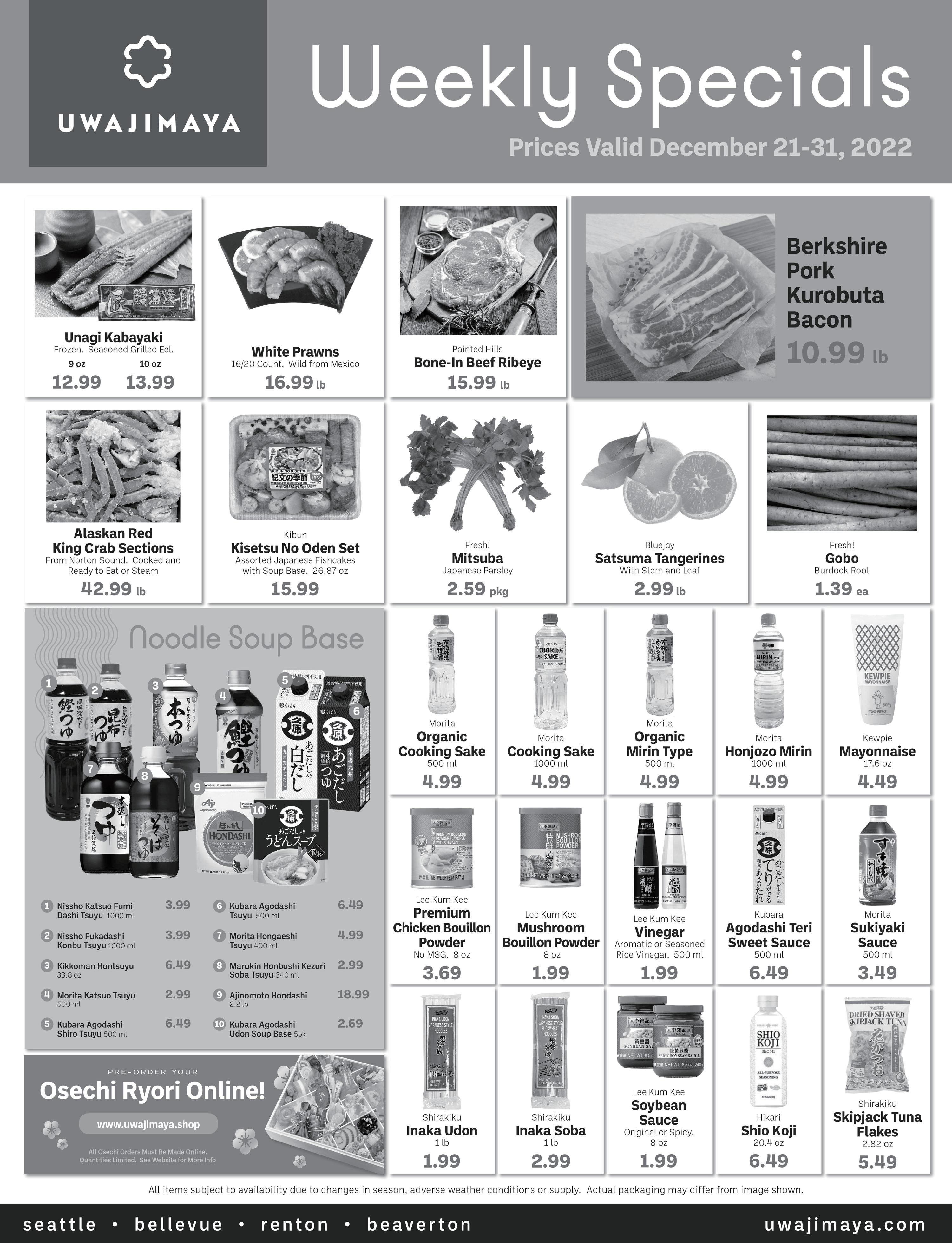
1980s
Despite the Post’s steady decline, Seattle’s Japanese
community still saw it as a cornerstone of local Nikkei culture and rallied to save it from closure. In July 1981, the Post suspended production for the first time since WWII. A group of community investors then came together to stabilize it with an infusion of funds and the Post reorganized as a corporation, The North American Post Publishing Company, Inc. Its directors were Yoshito Fujii, president and publisher, Edward Shigeru Hidaka, vice president, and Noboru Kageyama, business manager. The pool of community investors also included cousins Tomio Moriguchi, CEO of Uwajimaya, and Edward Tsutakawa of Spokane (brother of artist George).
With these funds, the Post began to modernize,
20 The North American Post Vol. 77 Issue 24 January 1, 2023 napost.com
NAP History, from page 9
purchasing new typewriters and large-format camera equipment to streamline production (the former described in Edward Echtle, “Pre-Computer Days of the NAP, Historic Typewriters Find Renewed Purpose,” napost.com, Dec. 2022).
As the methods of production changed, so did the NAP’s leadership and staff. In 1984, Noboru Kageyama became president and publisher and longtime editor Takami Hibiya retired. Shiro Masaki also joined as editor through 1988. The following year Akiko Kusunose joined the Post, beginning her long association with the paper while Yoshito Fujii retired as president.
In this era, the passing of the founding Issei and
Nisei generations received frequent mention in the Post. In 1987, former “North American Times” editor and publisher Sumiyo Arima died at age 87.
By the late 1980s, the number of investors was dwindling and Noboru Kageyama decided to retire as well. Tomio Moriguchi’s long history of community building and his family’s long relationship with the Post, as business neighbors and supporters, prompted him to accept the role as the Post’s publisher, while H.T. Kubota briefly served as vice president, Tsuyoshi Horike as second vice president, and Minoru Tsubota as secretary.
Under the new leadership, Akiko Kusunose became editor and the Post launched a sister publication, the
English Language “Northwest Nikkei,” to capture more readers, especially the Sansei and Yonsei generations who were reaching adulthood, living and working beyond Nihonmachi. Among the first stories reported was the passage of the Civil Liberties Act of 1988 in which the federal government granted longawaited redress funds for Japanese and Japanese Americans incarcerated during WWII.
In 1989, the Post marked the passing of longtime publisher H.T. Kubota, noting his decades of commitment to keeping the paper viable through difficult times.

21 The North American Post Since 1902 napost.com
to
be continued
Seattle Delegation Visits Kobe for 65th Anniversary Celebration INTERVIEW
By Elaine Ikoma Ko For The North American Post
This past Nov. 16-19, I joined 17 other delegation members with the Seattle-Kobe Sister City Association (SKSCA) in visiting Kobe, Japan, in commemoration of the association’s 65th year anniversary. The trip reciprocated an Oct. 29-Nov. 2 Seattle visit by Kobe Mayor Kizo Hisamoto and his colleagues (napost.com, Nov. 13).
In Japan, the group joined with Seattle Mayor Bruce Harrell‘s delegation, which had been in Tokyo the prior week. Harrell’s group was part of the International Leadership Mission of the Seattle Metropolitan Chamber of Commerce, working in partnership with Greater Seattle Partners, a regional trade and investment organization. Together, the combined delegations totaled 77 people.
What follows is an interview with Karin Zaugg-Black , the sister-city association’s 65th anniversary chair and long-time association leader.
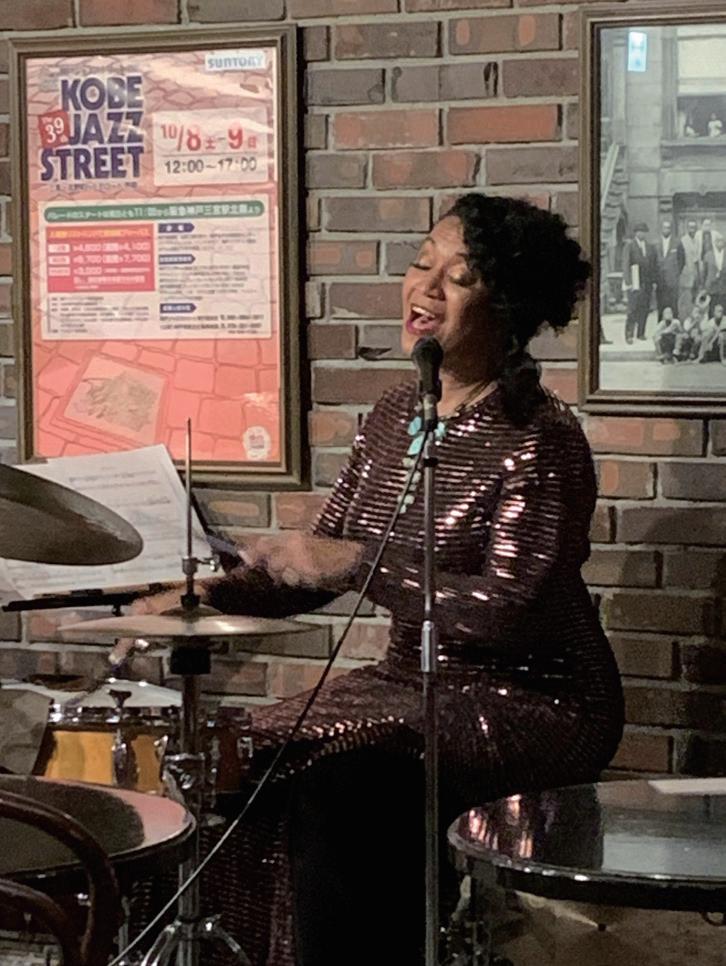
What is the significance of the 65th anniversary of the SeattleKobe Sister City Association? What were the themes for this year’s celebration?
Seattle and Kobe were the first sister-city associations for both cities. President Dwight Eisenhower issued the first sister-city concept and program in 1956. Seattle and Kobe established their program a year later, so we were early adopters of the idea of creating grassroots exchanges between the people of our two cities. Commemorating 65 years of continued relations is a milestone certainly worth celebrating.
Our delegation to Kobe and the Kobe delegation’s earlier visit to Seattle focused on the themes of environmental issues and reducing carbon emissions through discussing topics like alternative fuel sources such as hydrogen. Our sister ports of Seattle and Kobe also shared information and are learning from each other as we tackle shared challenges.
Letters to the Editor
Other themes for the delegations were trade and economic development, high speed rail, emergency preparedness and community policing.
While in Seattle, Mayor Hisamoto was also looking at technology solutions and examining our local library system and airport to glean new ideas to take back to Kobe.
It is a testament to our long sistercity and sister-port relationships that we continue to engage with these partners that we have a long history with. What is most exciting is that we are always discussing different topics based on the needs of each city in the present. In the process, we are creating new exchanges and activities to further strengthen our bonds and involve more people.
What has been your role with this Association and this anniversary delegation?
I am a past chair of the SKSCA and have been a board member since 1999. I chaired this year’s Anniversary Planning Committee.
From 1993-1996, I worked for the Kobe Mayor’s Office on the Japan Exchange and Teaching (JET) Program. When I returned home to Seattle in
1997, I started volunteering with SKSCA. Then, I was on the planning committee for the 40th sister-city anniversary and 35th sister-port anniversary so this is my sixth time to be involved as an organizer for sister-city anniversary activities and exchanges.
A cool fact: Stacey Jehlik , with the City of Seattle’s Office of Intergovernmental Relations, was also in the JET program from 1996-1997. She worked on the 40th anniversary from the Kobe Mayor’s office — so this is the sixth anniversary we have worked on together!
What do you think was special about this particular anniversary and delegation?
The sister-city association has worked tirelessly to connect Seattle and Kobe residents through activities or passions that they already have, like baseball or jazz, and then add the international element to it. This year, as we brainstormed with the City of Kobe organizers, we created the idea of small-business exchanges and pairing businesses that create cookies, coffee and beer!
It’s been wonderful to have our small-business partners get to know each other and have fun introducing
tasty products! Seattle’s Lucky Envelope Brewing and Kobe’s Rokko Beer owners each spent a week in each other’s cities, learning and brewing beer together – the tasty result will be a sister-city beer in the coming weeks!
Robin Wehl Martin of Seattle’s Hello Robin traveled to Kobe and introduced her yummy cookies to Kobe people at four events. We hope to do a reciprocal visit with Pastry Chef Shuhei Hayashi of Mont Plus of Kobe.

Shaun Peterson , a local Native American artist, also joined the delegation and unveiled a new friendship totem-pole design that will replace the original one in Kobe. Local jazz/blues singer Jacqueline Tabor also treated us to some fantastic performances!


Are there SKCSA announcements you wish to share?
The SKSCA welcomes volunteers to get involved in our projects and exchanges. You can follow us on social media and sign up for the newsletter. An upcoming anniversary event will be the Sister City Beer Launch, Friday, Jan. 6, from 5 – 7 p.m., at Lucky Envelope Brewing, Ballard.
Info: seattlekobe.org
A reader wrote in response to the above note, “What is the ’Murohashi Period?’ I don’t even know what that is other than thinking hard that it was Misa.”
In reply, Misa Murohashi was indeed the editor of this paper from March 2016 to mid-April 2022. I believe that readers should know this, because producing a community newspaper is an underpaid labor of love. It is reasonable for them to remember who did this for them in the recent past.
I termed Misa’s era the “Murohashi Period” as an apt, highly complimentary reference to the similar sounding “Muromachi Period” (AD 1336 – 1573).
The latter is an era when Japanese culture flowered, yet ended with the arrival of “western barbarians” at the gates of Japan, in the form of Portuguese sailing ships (1543) followed by Roman Catholic missionaries (1551).

World-renown examples of accomplishments during the Muromachi Period include:
• the building of the famous Kinkakuji golden temple in Kyoto.

• the construction of rock gardens to foster meditation, including the one at Ryoan-ji Temple, also in Kyoto.

My view is that if most NAP readers are going to go through life with Japanese faces, then we should strive to learn the broad strokes of Japanese history so that we can be world citizens, knowledgeable when we converse with Japanese people and when we visit Japan. Karen J. Yuen’s “Muromachi Period, Japanese Art History,” in her YouTube “Little Art Talks” series, shows what is possible even for young Americans in their twenties — Ed.
A First Look at the Ireizo (Dec. 9).
I appreciated your article describing your experience with the Ireizo database. I’ve identified 32 family members who were incarcerated and it was a lot of work!
Some things I’ve noticed:
• The source people are gone, and it’s my Sansei siblings, cousins, and in some cases, Yonsei second-cousins who are trying to find family information. It’s a little sobering to be the “oldest generation.”
•Sometimes the family info we have differs from what’s in the Ireizo, e.g., year of birth.
•Many of my relatives had both Japanese and American names.
Sometimes the Japanese name is listed first; other times second, and if you search in the wrong order, or include it or don’t include it, it won’t find them.
• Many of my Sansei cousins have Japanese names I didn’t know.
• The names we knew and called our relatives aren’t necessarily the ones they “registered” with when entering camps, e.g., “Auntie Natsuko” was listed as “Natsu;” my cousin “Jim” was listed as “Jimmy.” Again, searching for “Natsuko” or “James/Jim” came up empty.
In spite of this, I agree that it’s been a powerful starting place to gather and record some family history, and I would encourage others to get into it.
Susan Okamoto Lane
22 The North American Post Vol. 77 Issue 24 January 1, 2023 napost.com
Upper left: Karin Zaugg-Black and Stacey Jehlik flank First Lady Joanne Harrell and Mayor Bruce Harrell in Kobe. Photo: Alabastro Photography. Lower left: “Macklemore” cookie demonstration by Seattle’s Robin Wehl Martin of Hello Robin. Photo: Takumi Ohno
Middle: Jacqueline Tabor, Seattle blues jazz singer, performing at Club Sone, Kobe. Photo: Karen Zaugg-Black. Right: Shaun Peterson, local Native American artist, in Kobe, showing the design a new friendship totem pole. Photo: Alabastro Photography
Muromachi Period mural of the arrival of Portuguese trading ships. Image: public domain.
Ryoan-ji rock garden. Photo: Stephane D, CC BY-SA 3.0, Wikimedia Commons
Kinkakuji Temple. Photo: Jaycangel, CC BY-SA 3.0.
Bruce Rutledge, Neko Herder (Dec. 9).






























 Tomio Moriguchi Chairman, The North American Post Publishing Company
Tomio Moriguchi Chairman, The North American Post Publishing Company


























































 President
President














 By Elaine Ikoma Ko For The North American Post
By Elaine Ikoma Ko For The North American Post























































 By Aya Chiong-Bisbee For The North American Post
By Aya Chiong-Bisbee For The North American Post




























